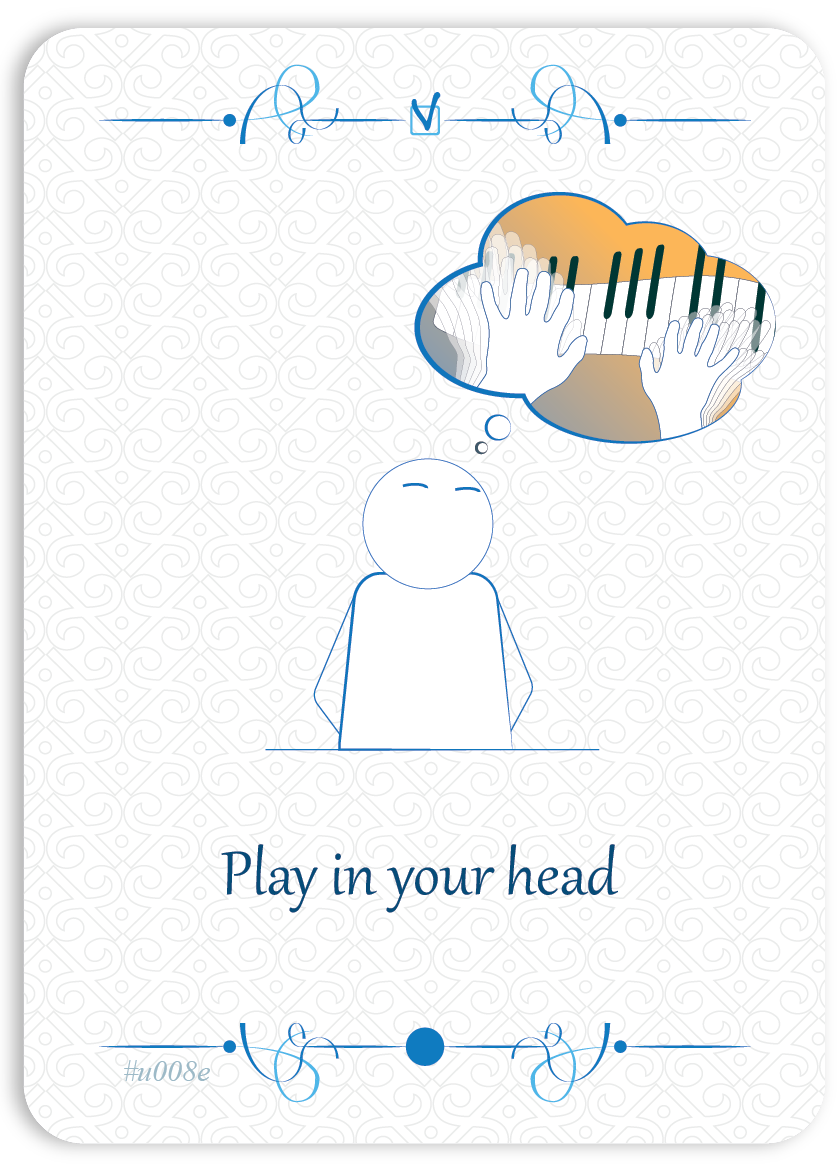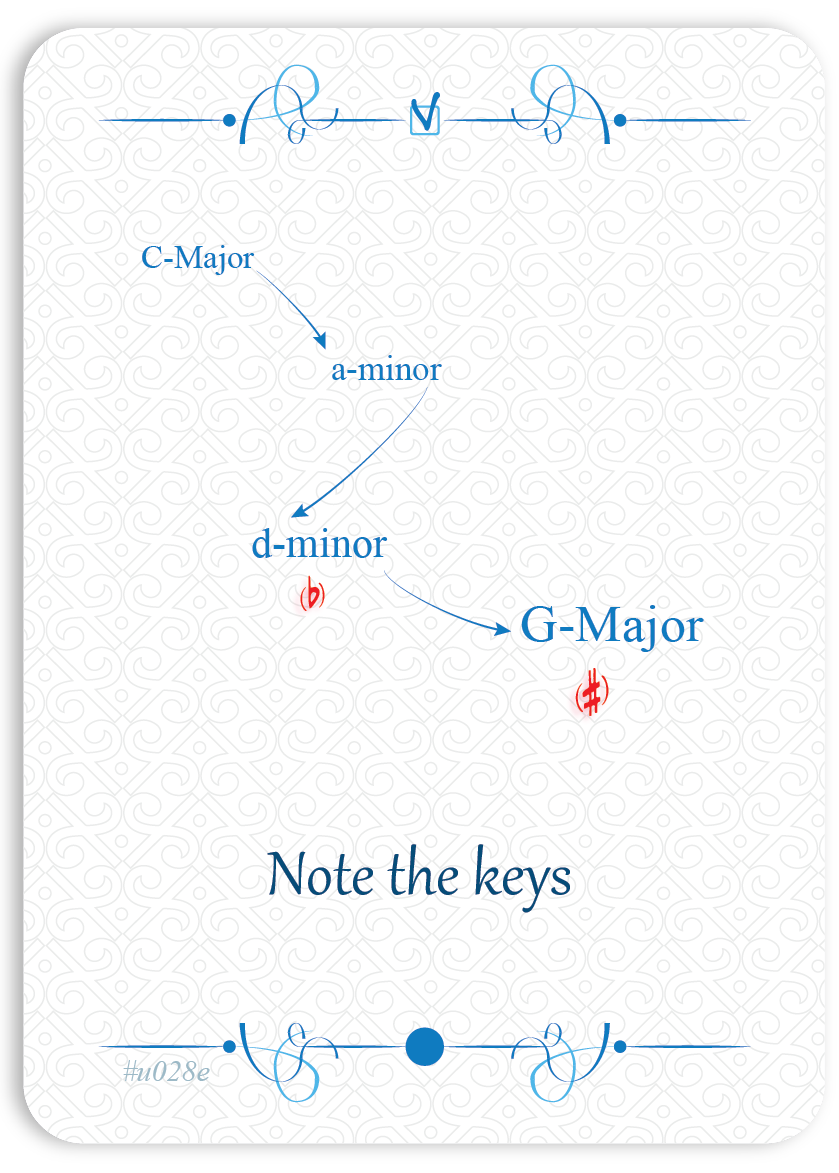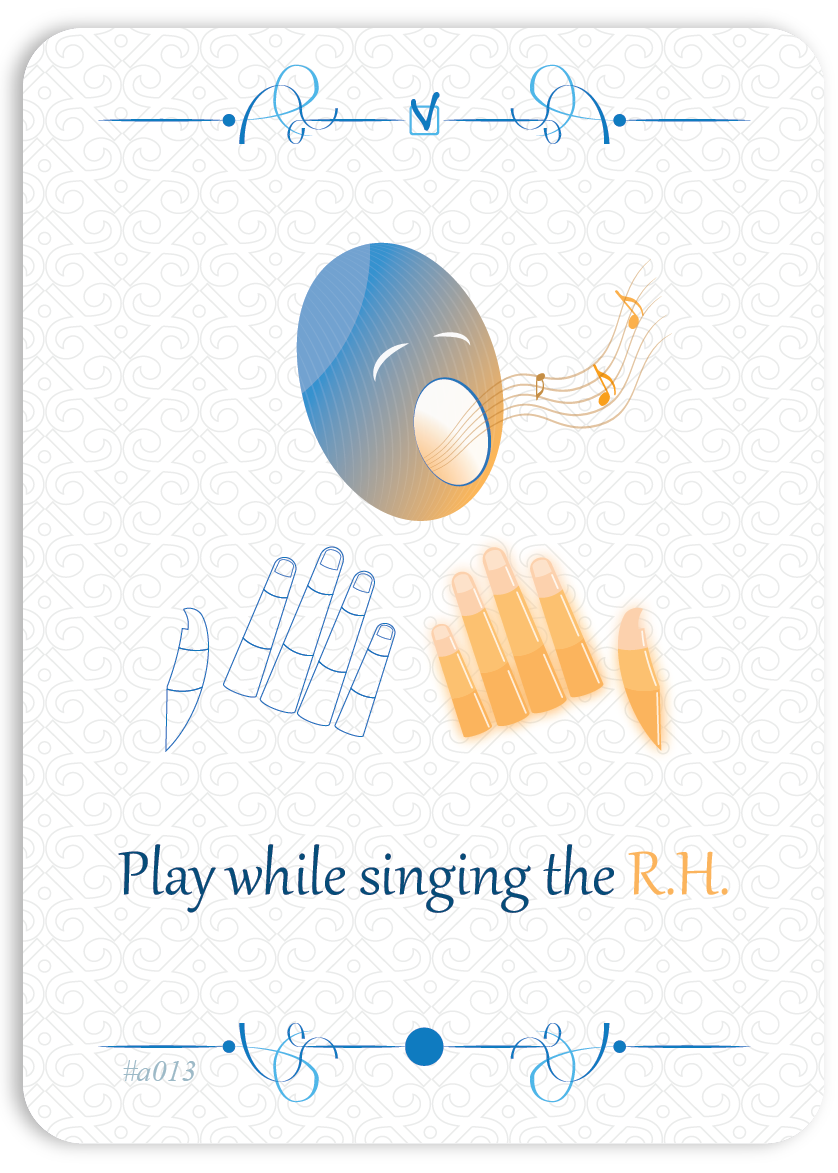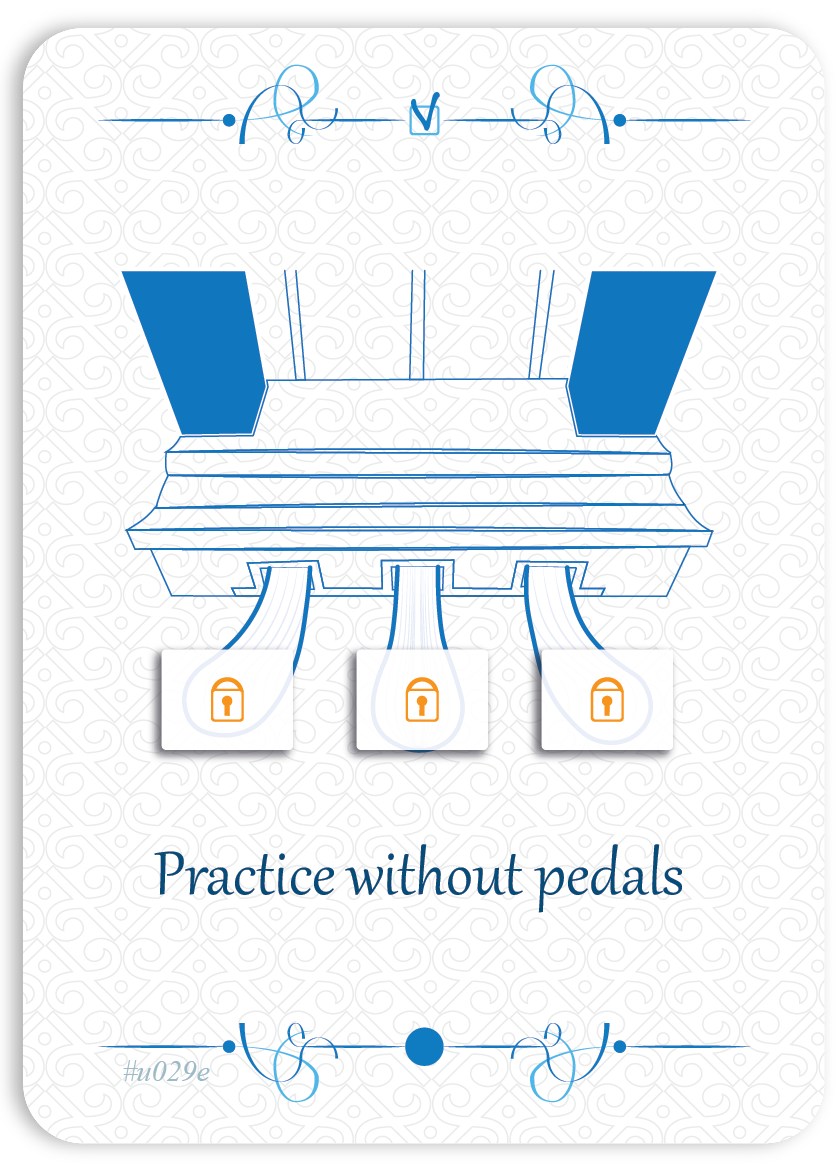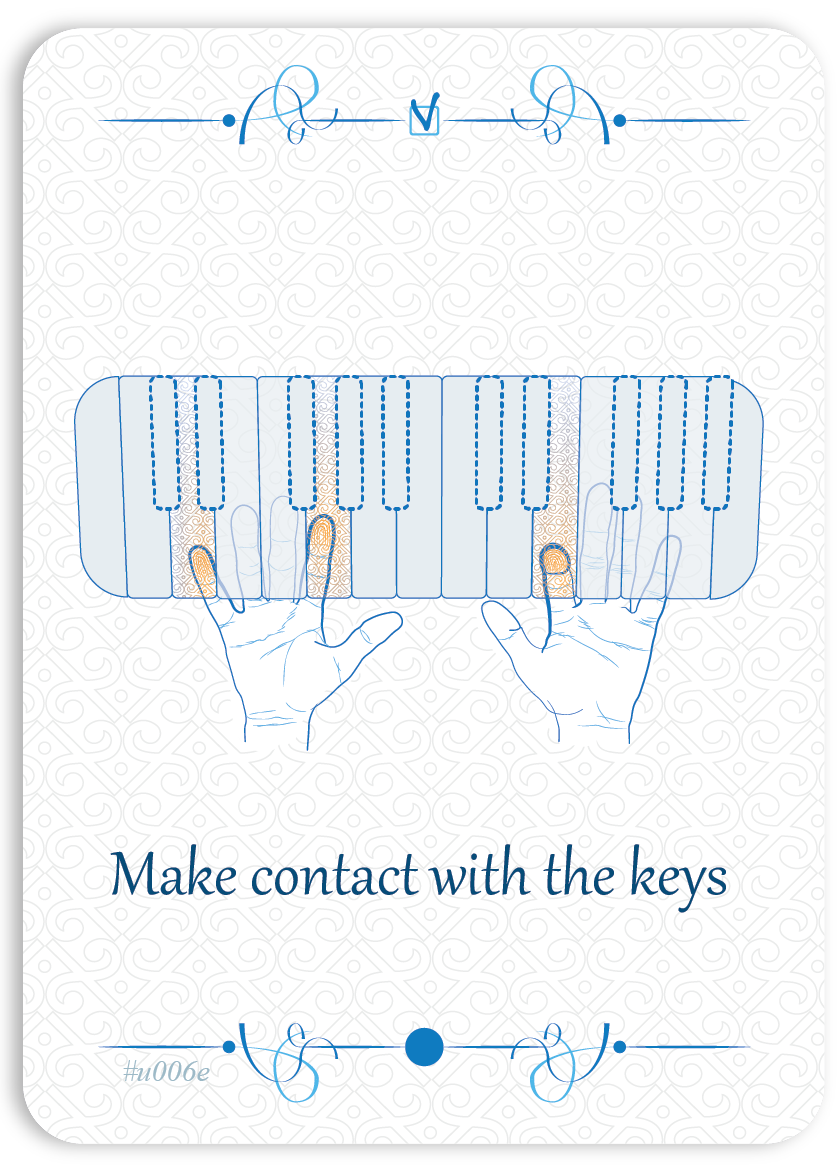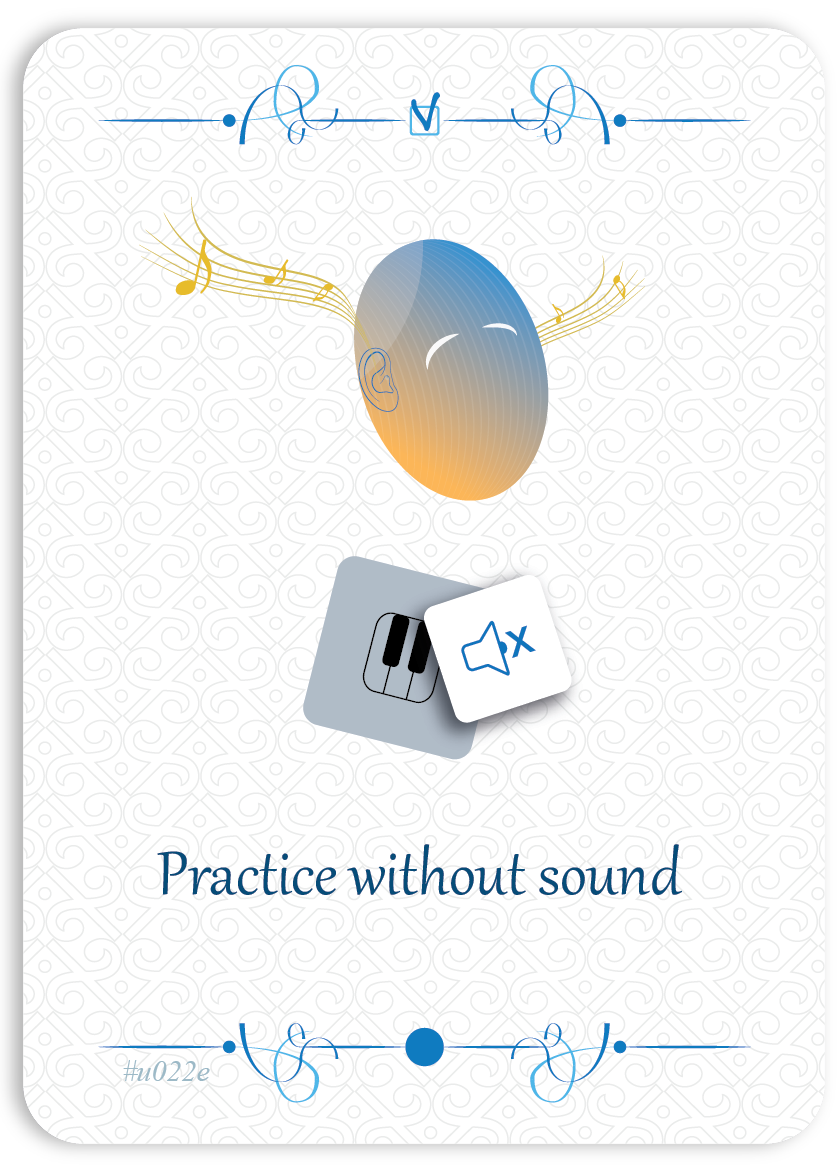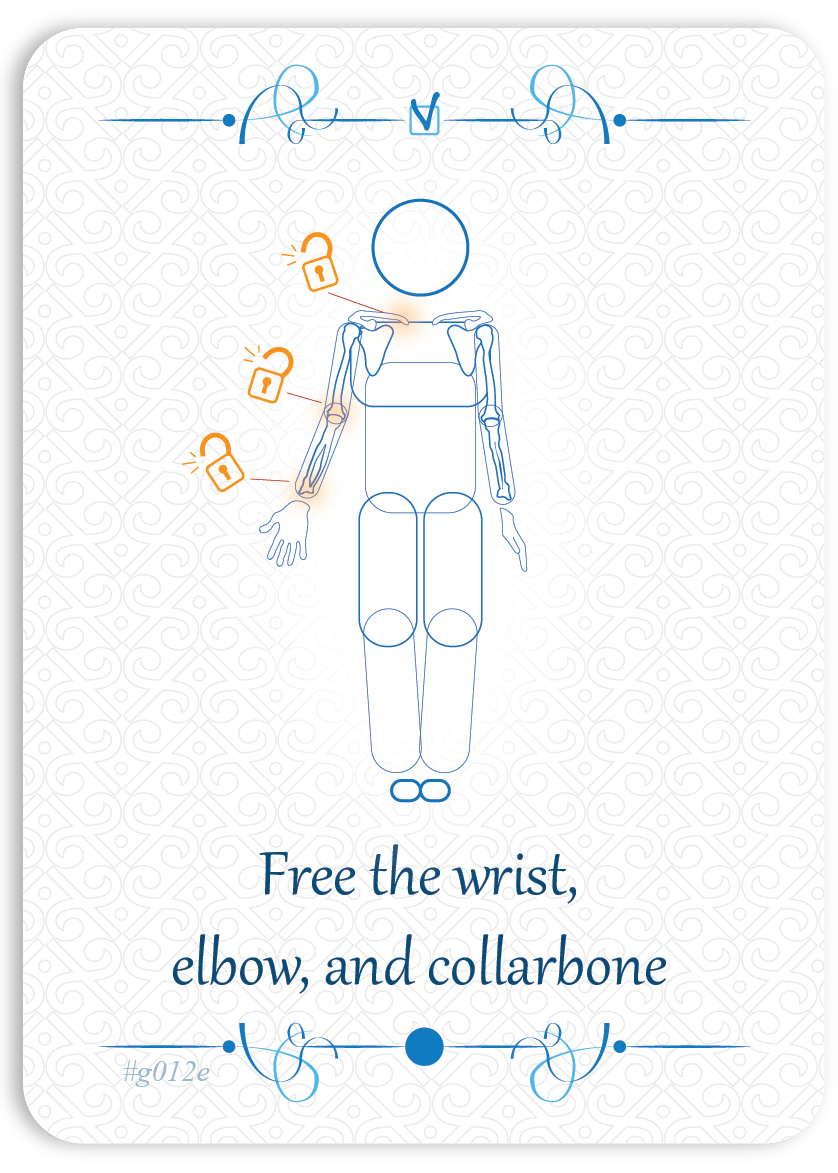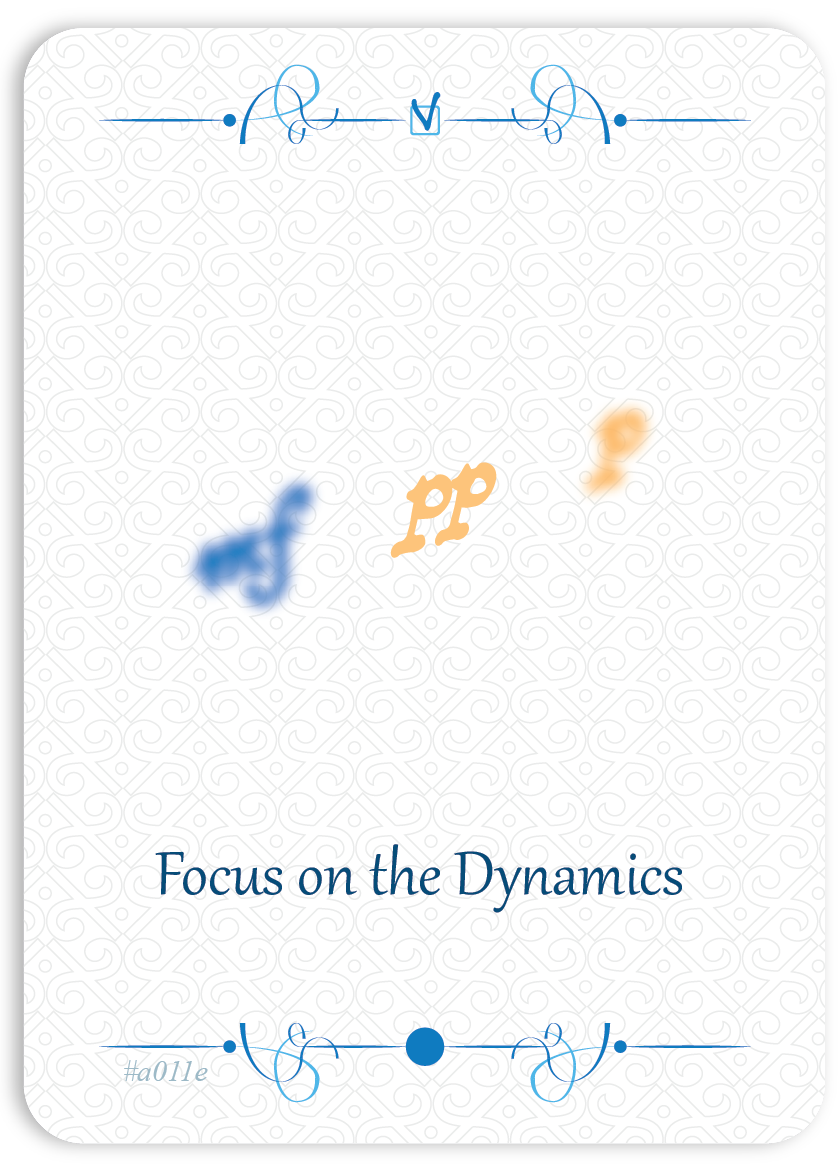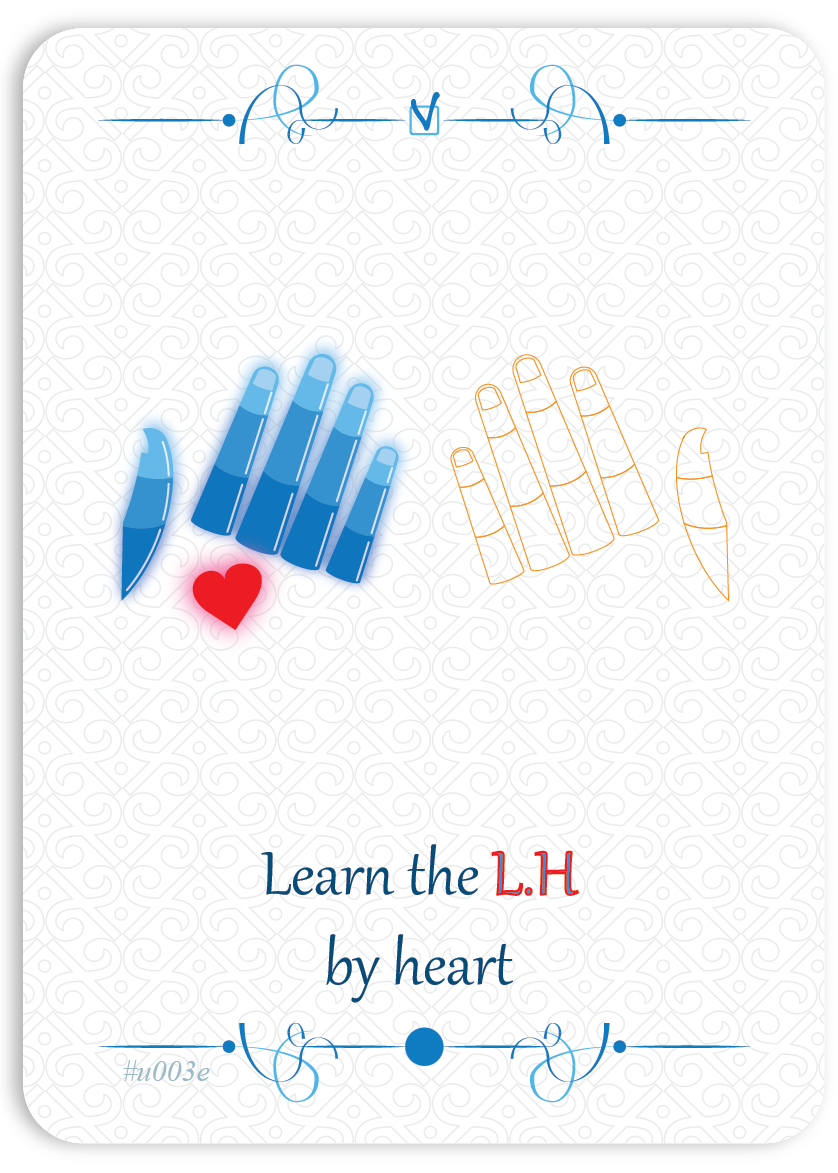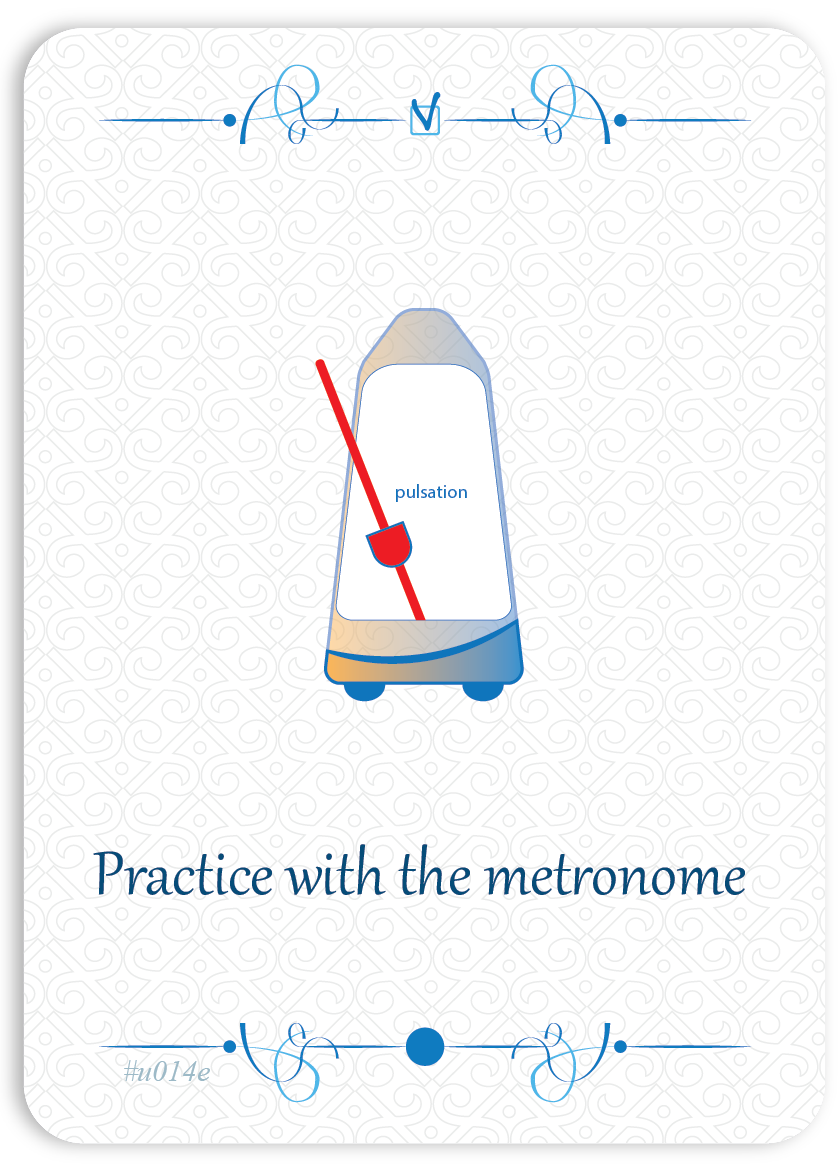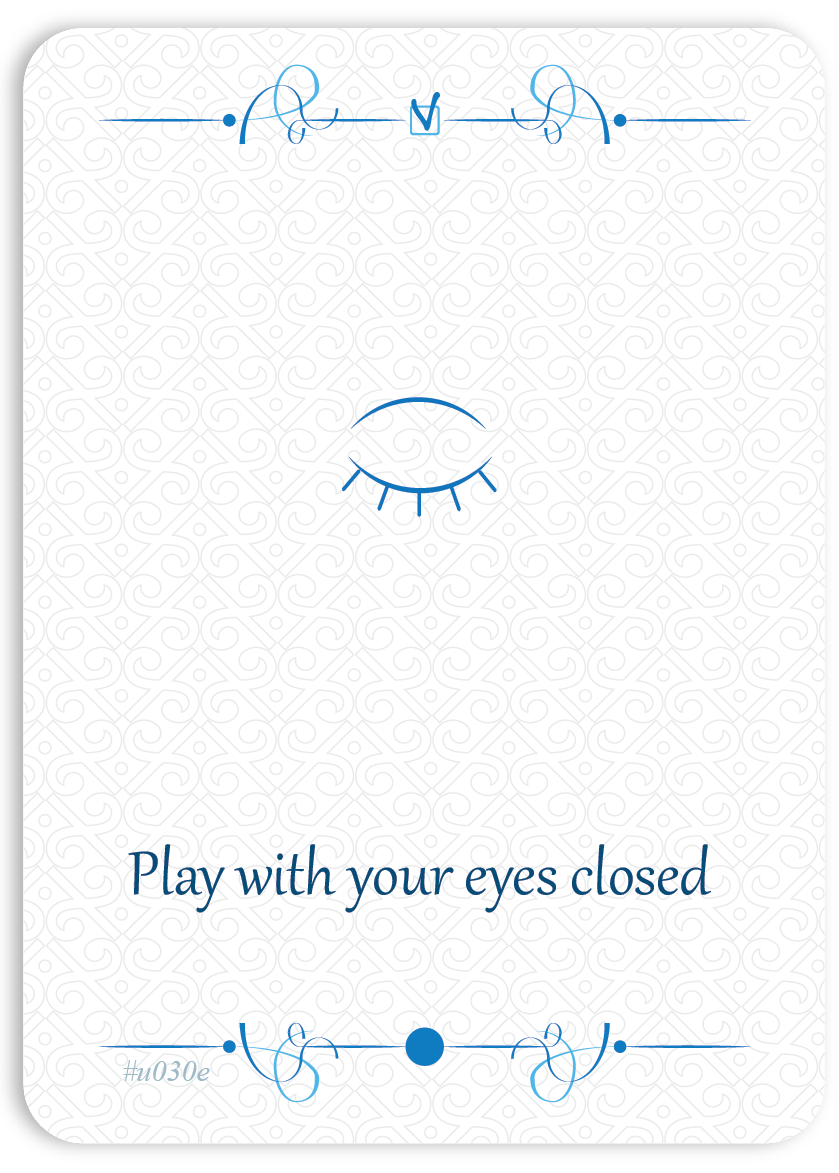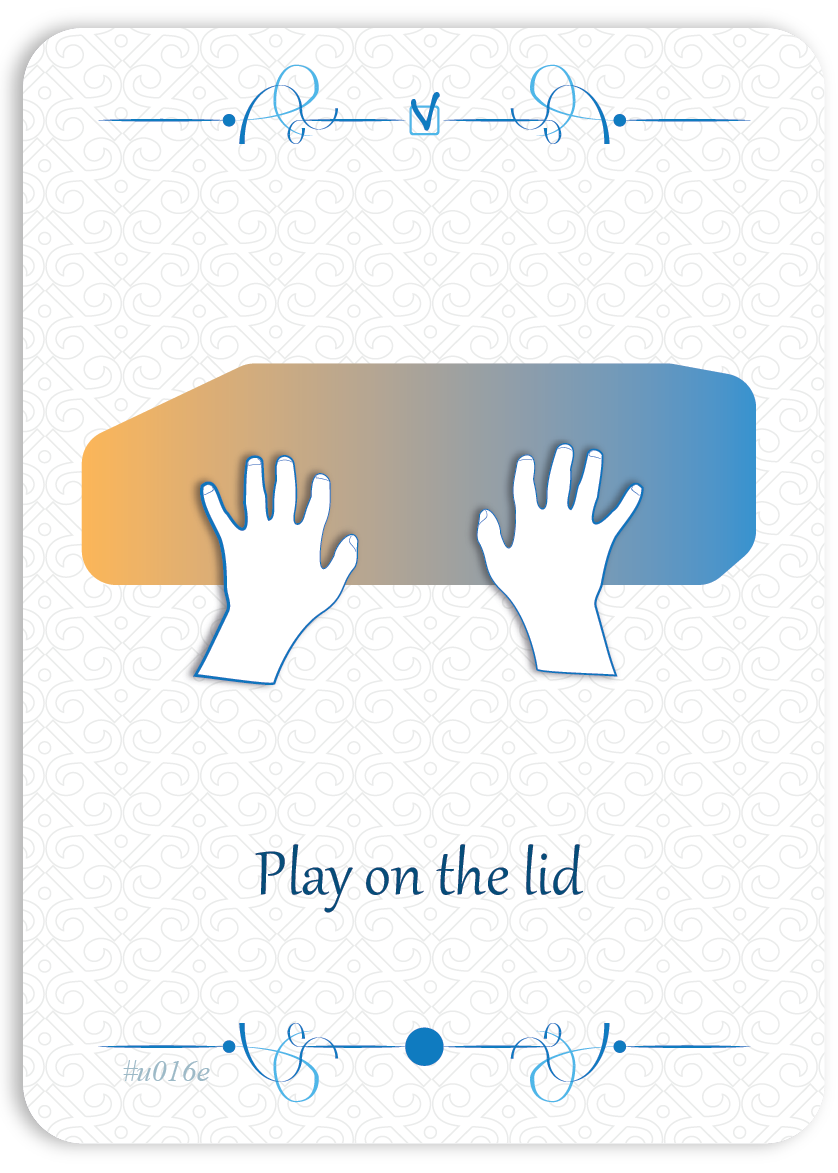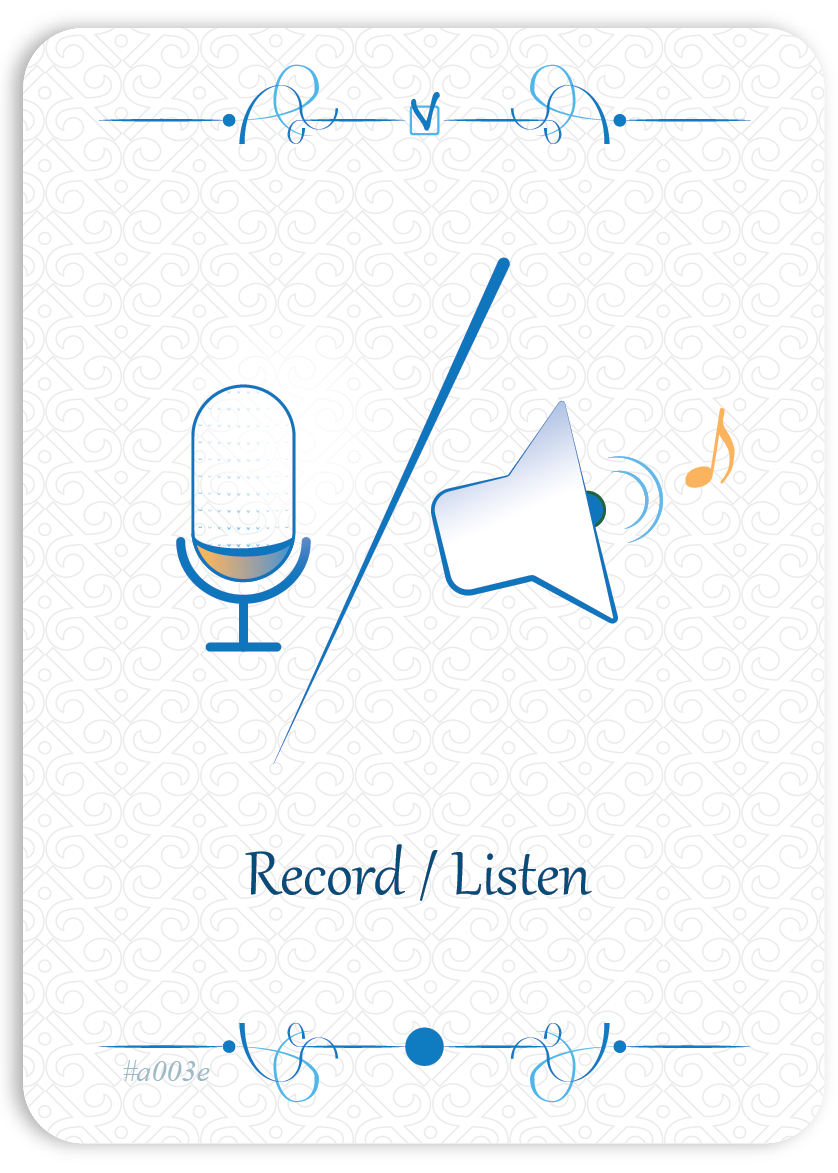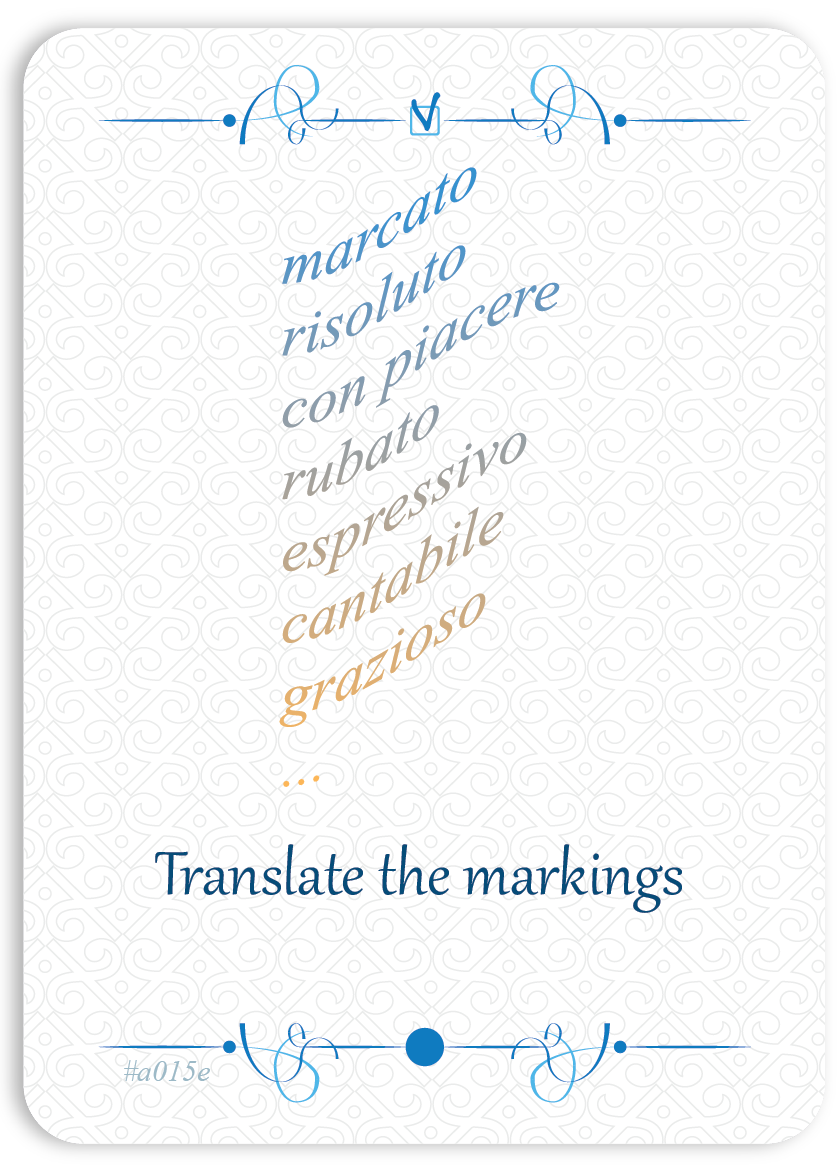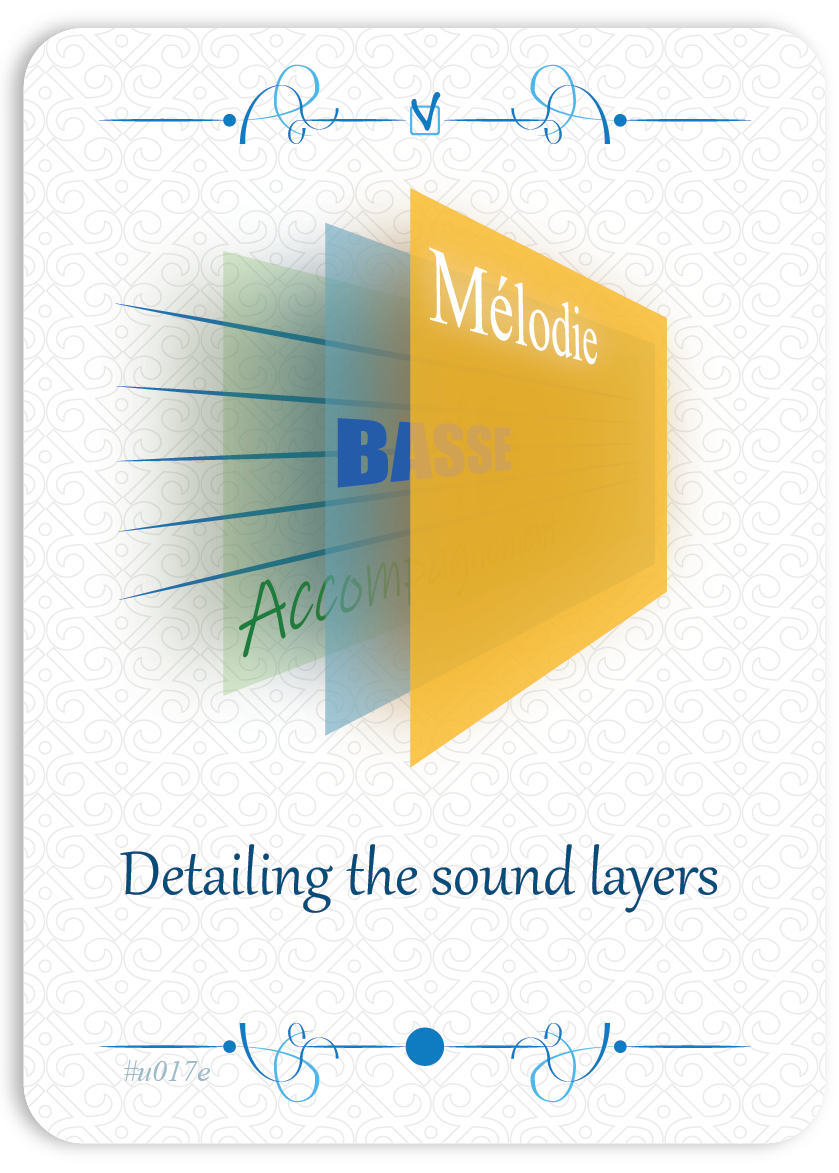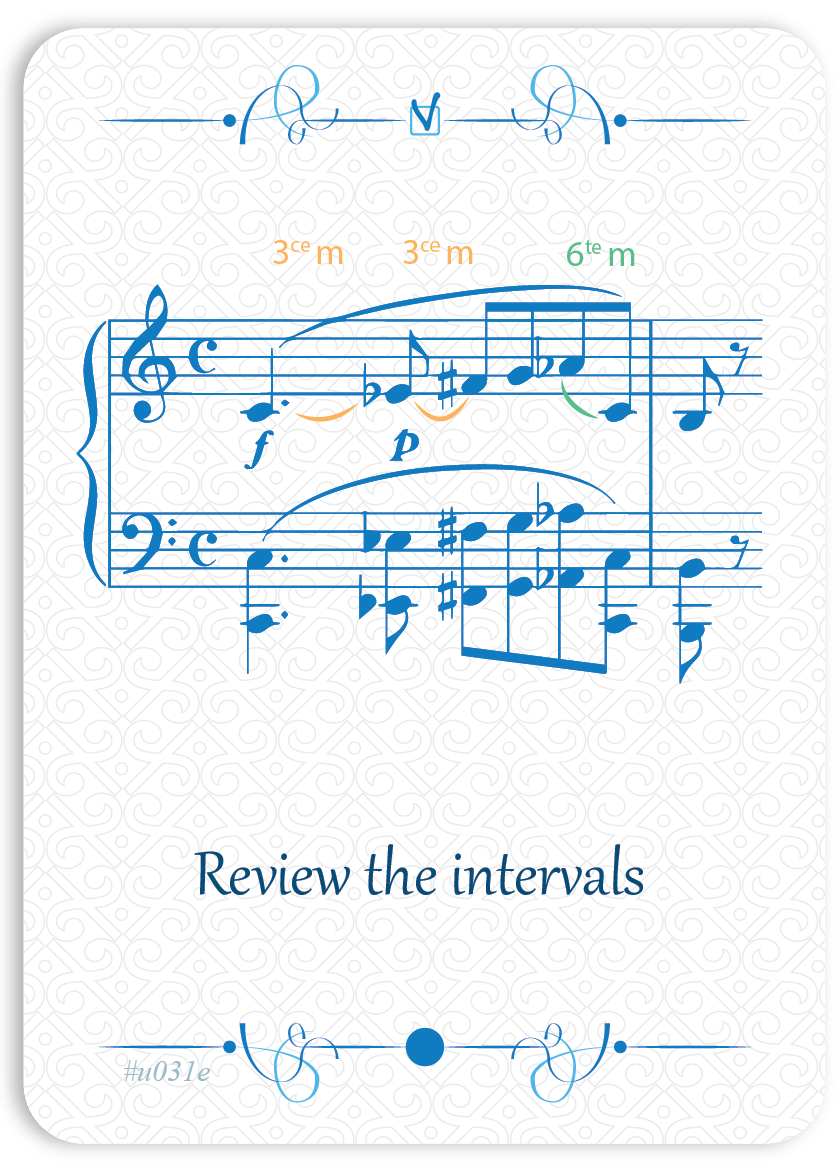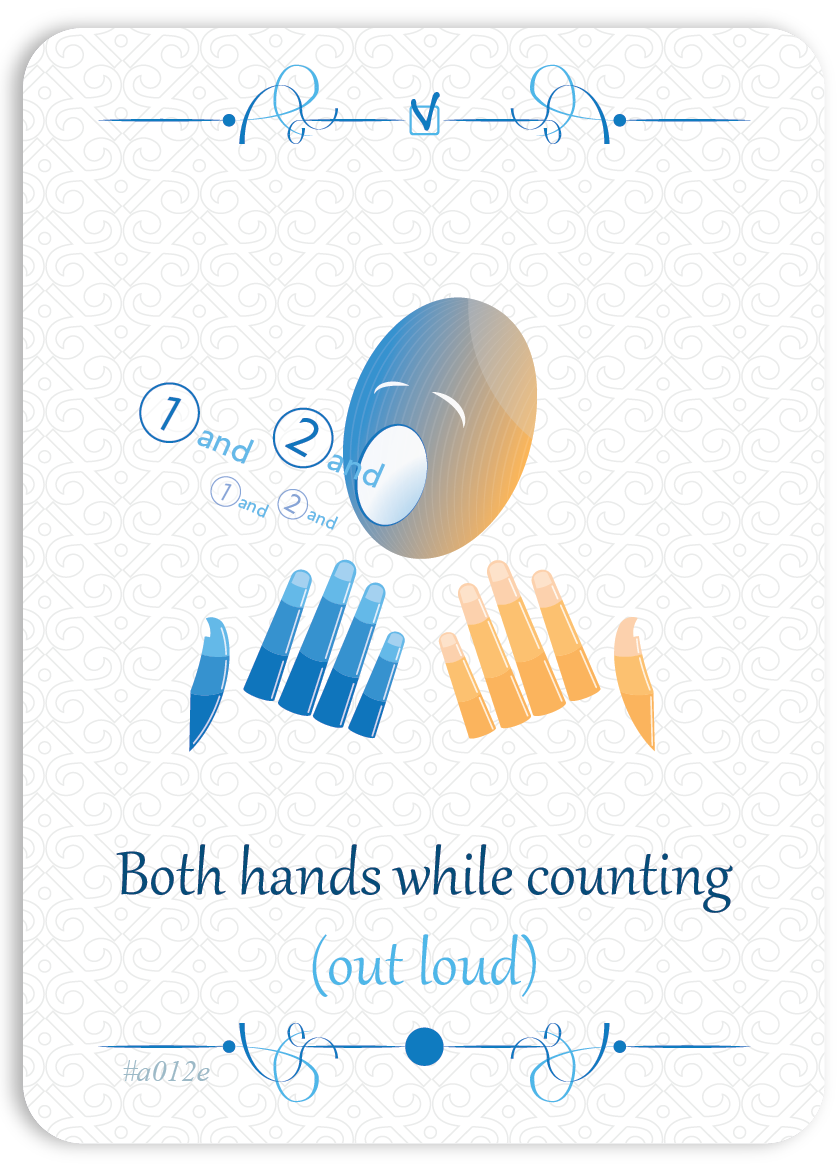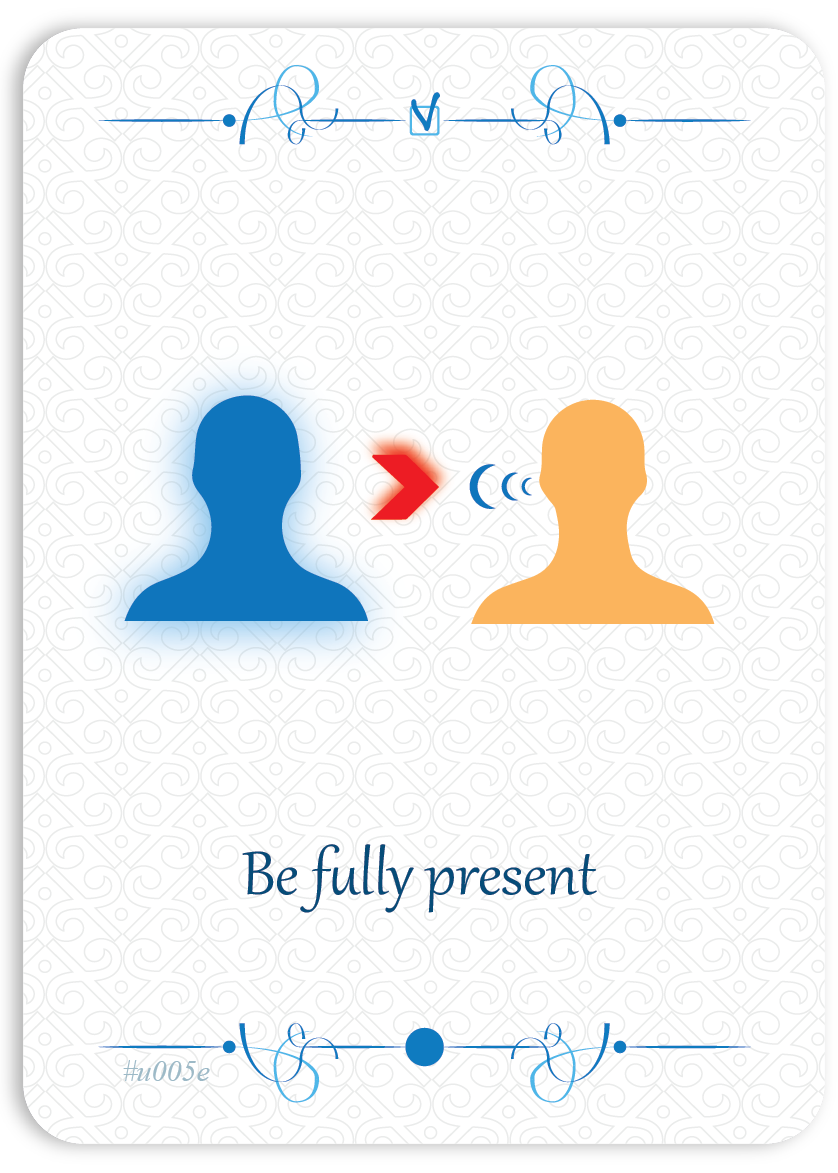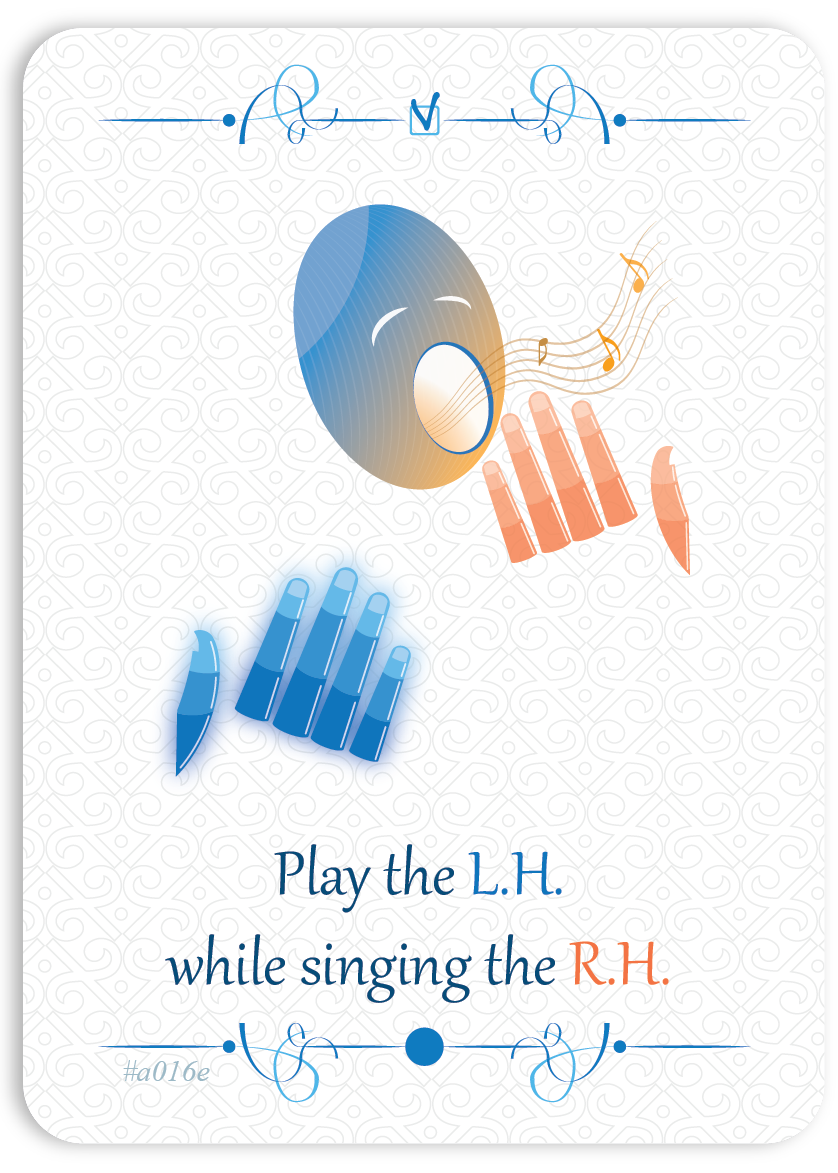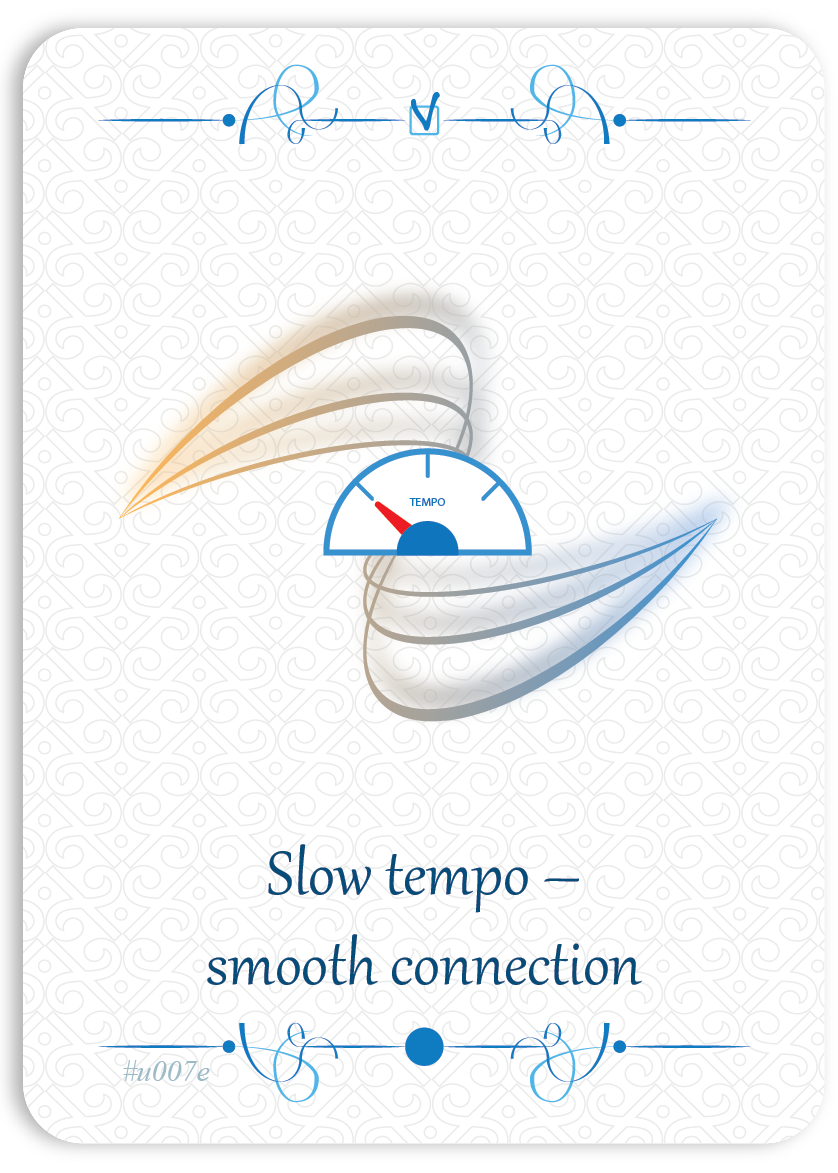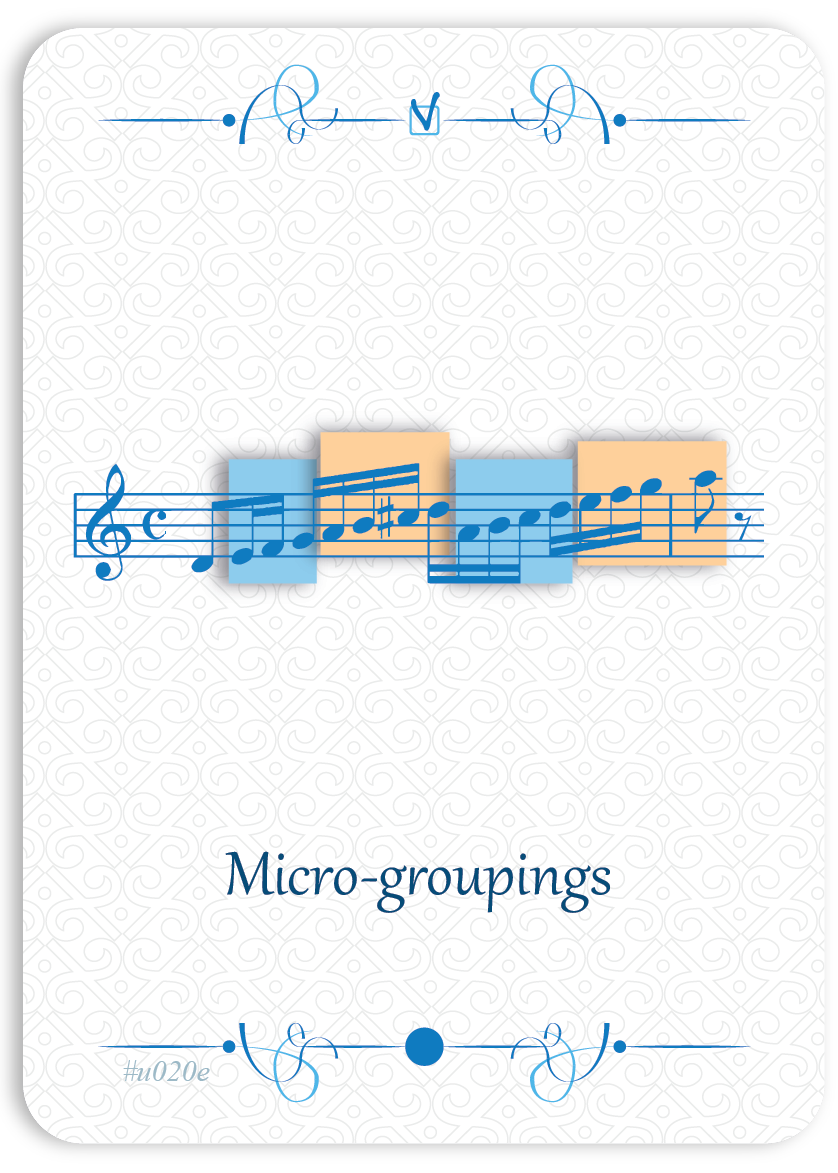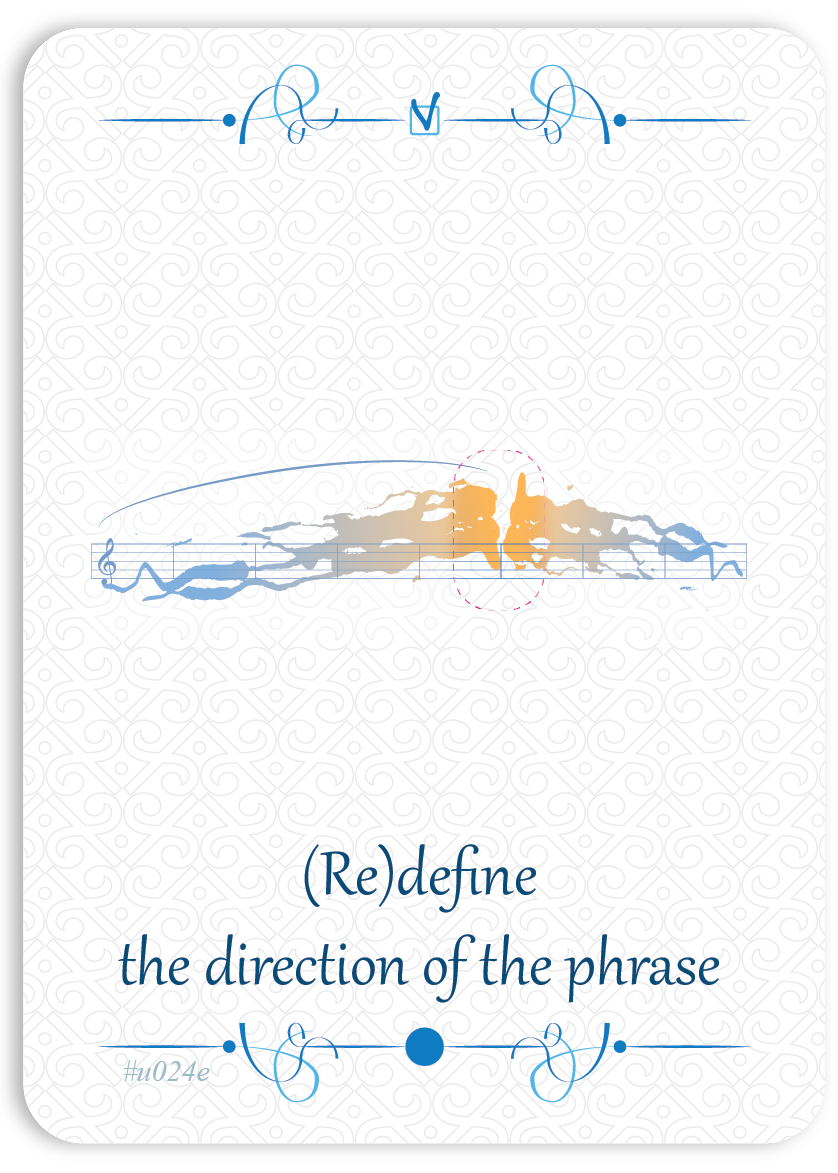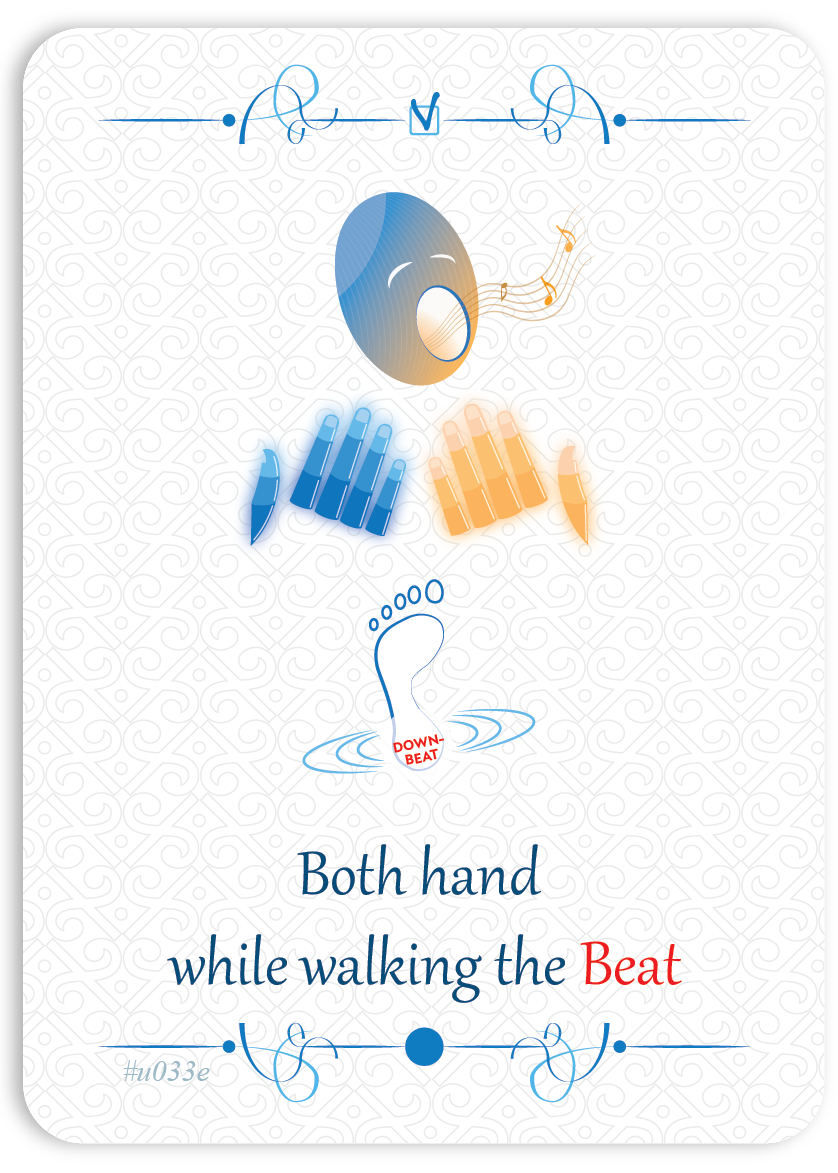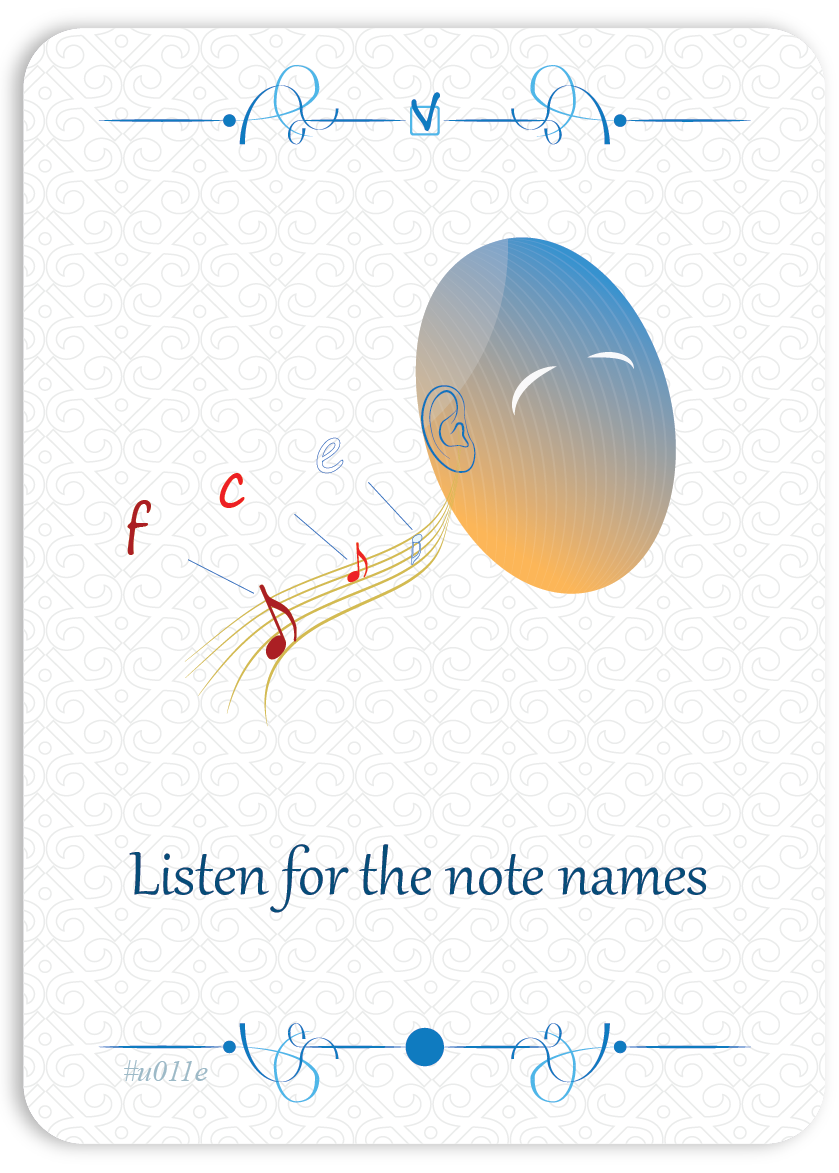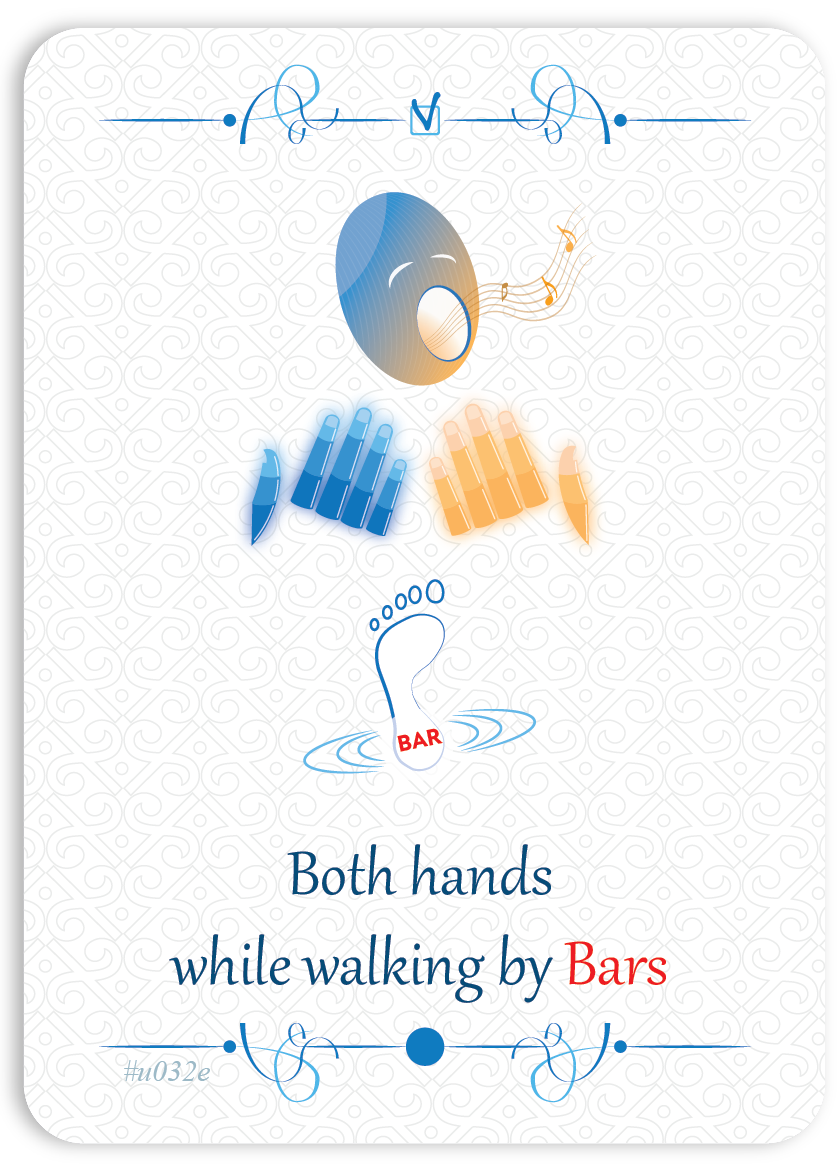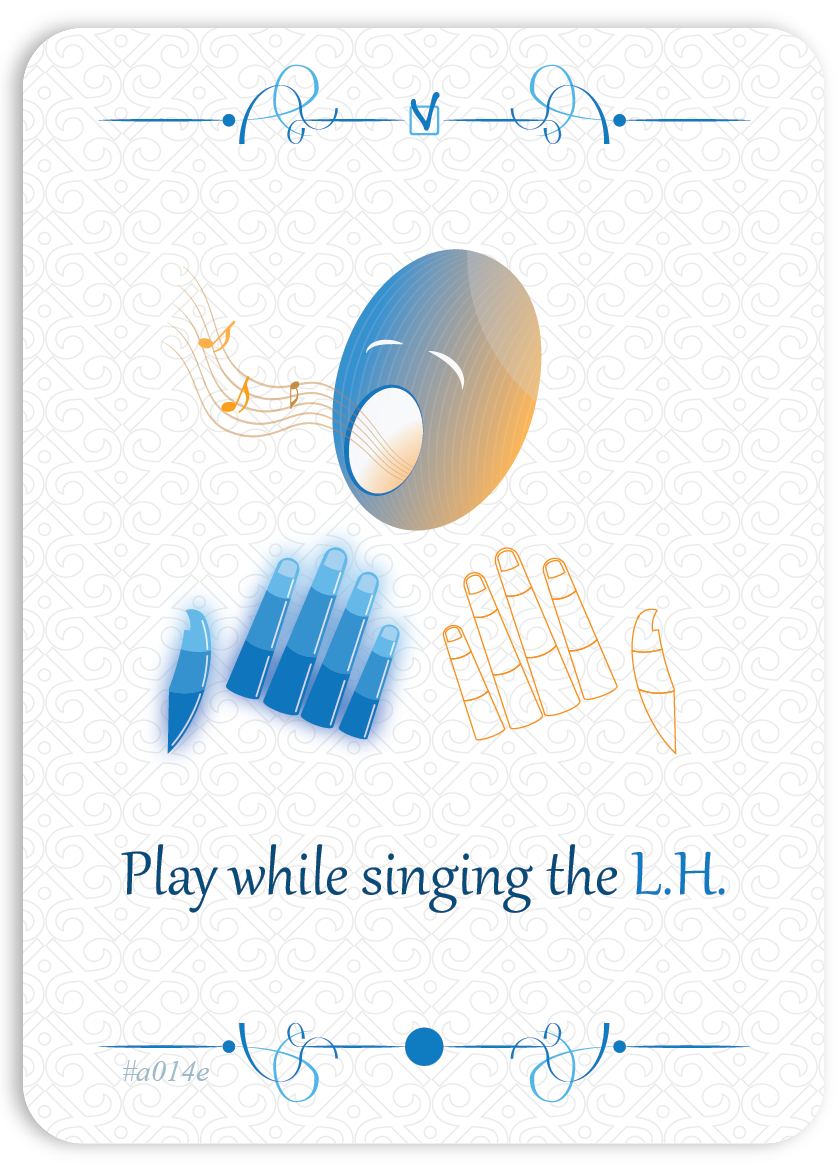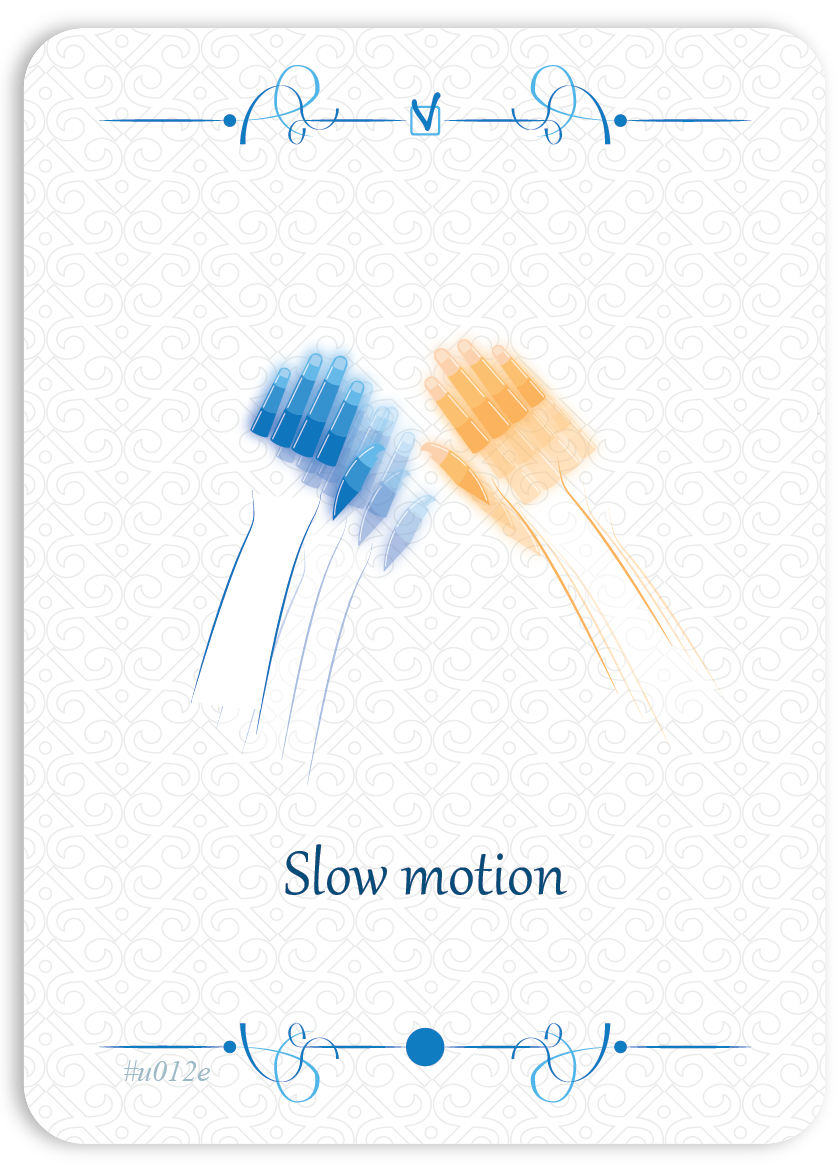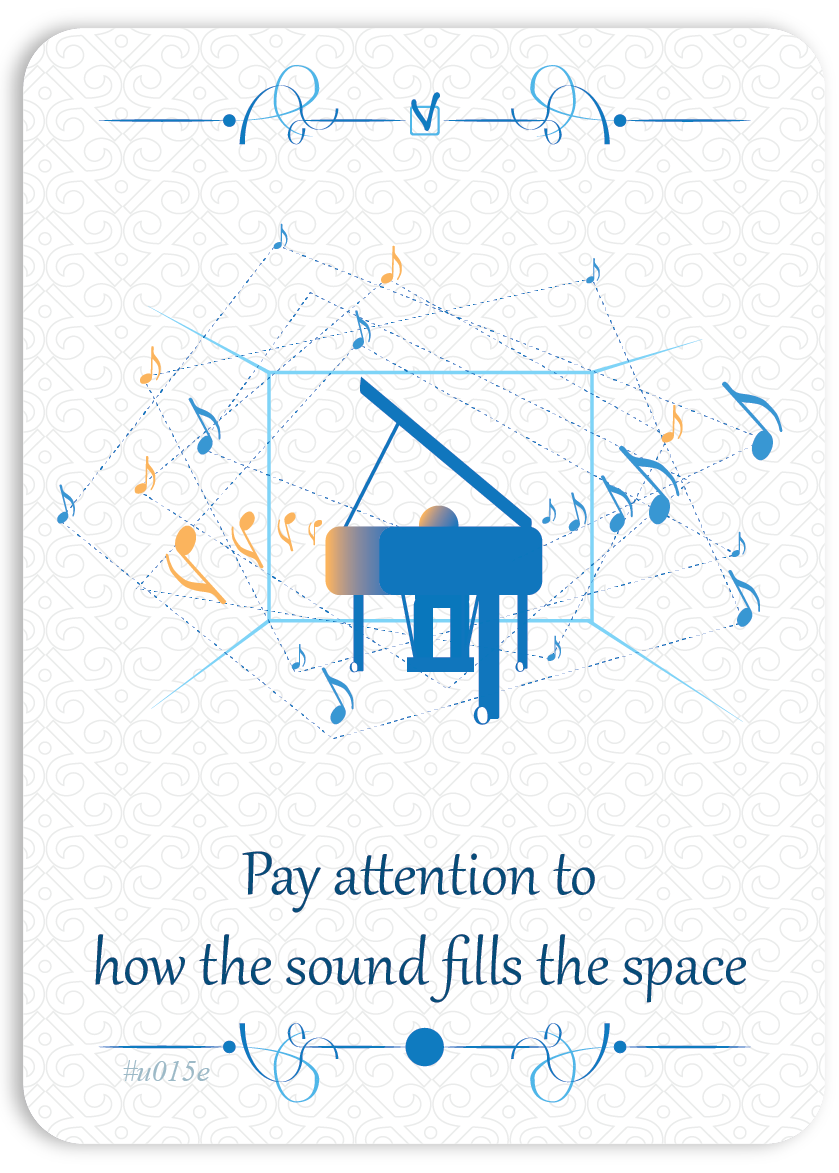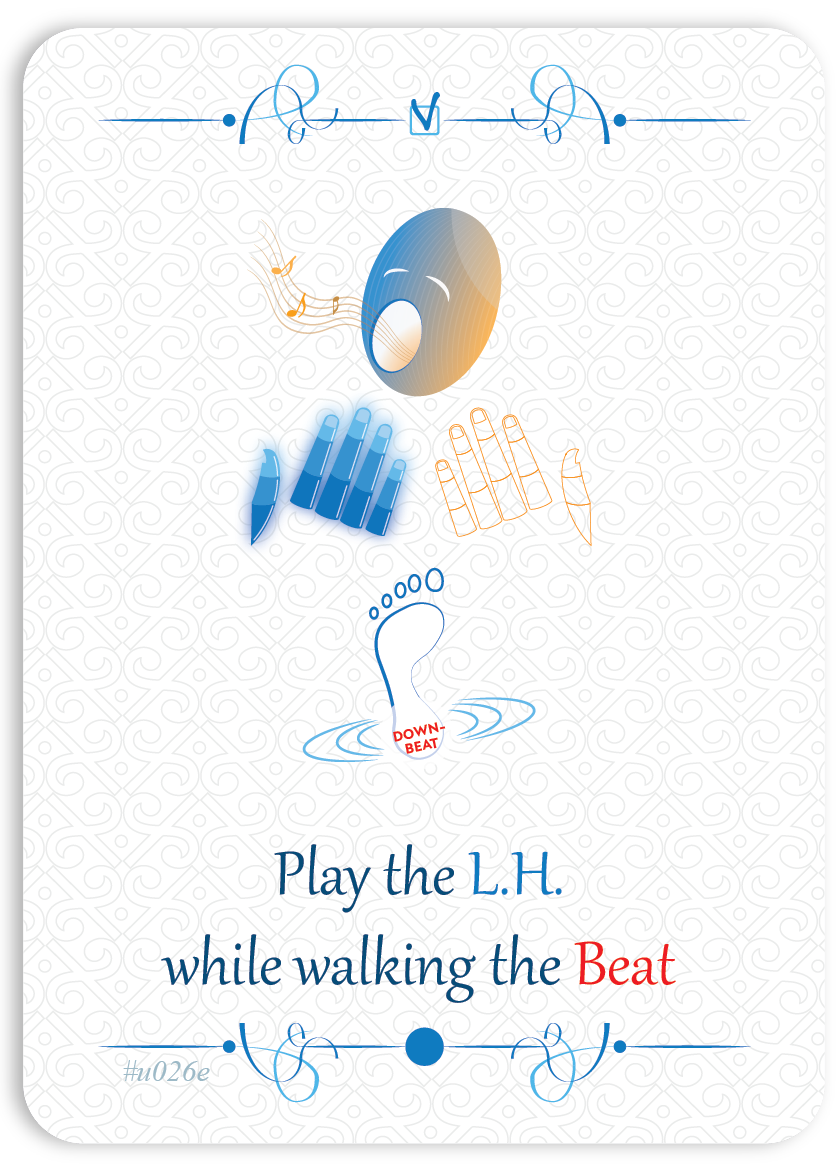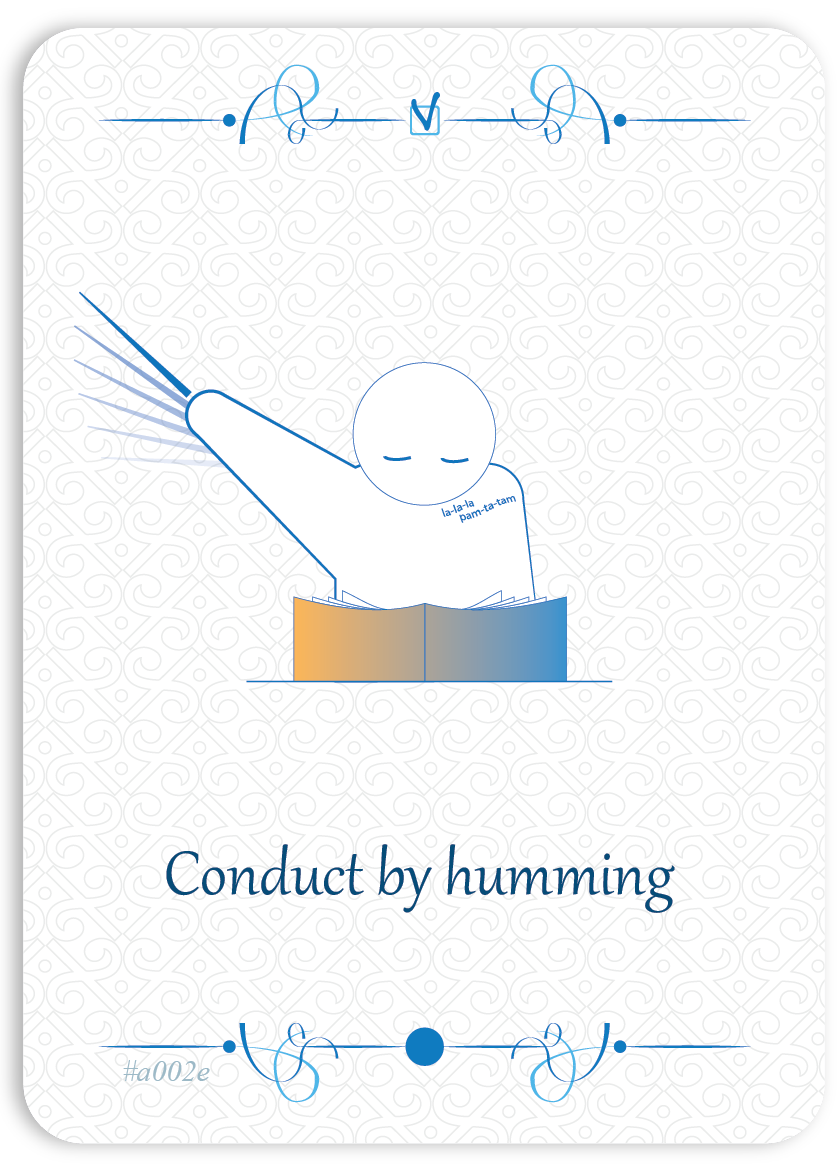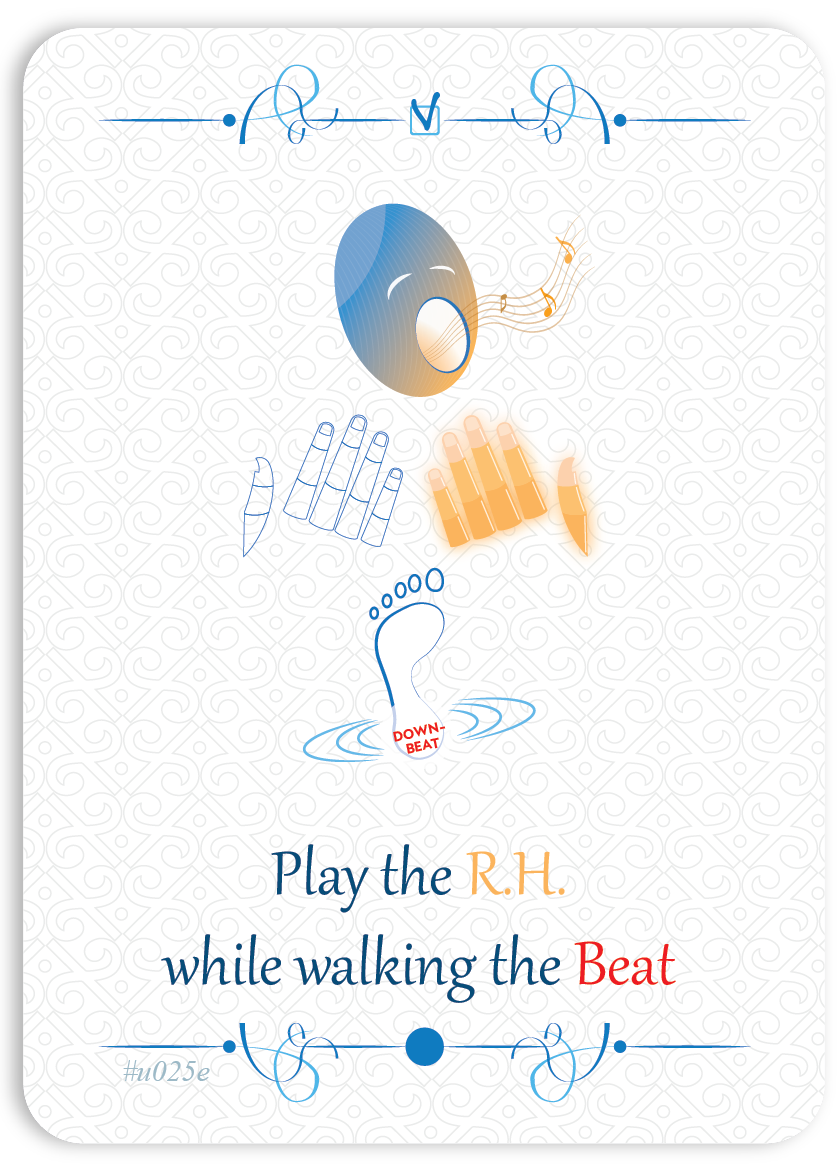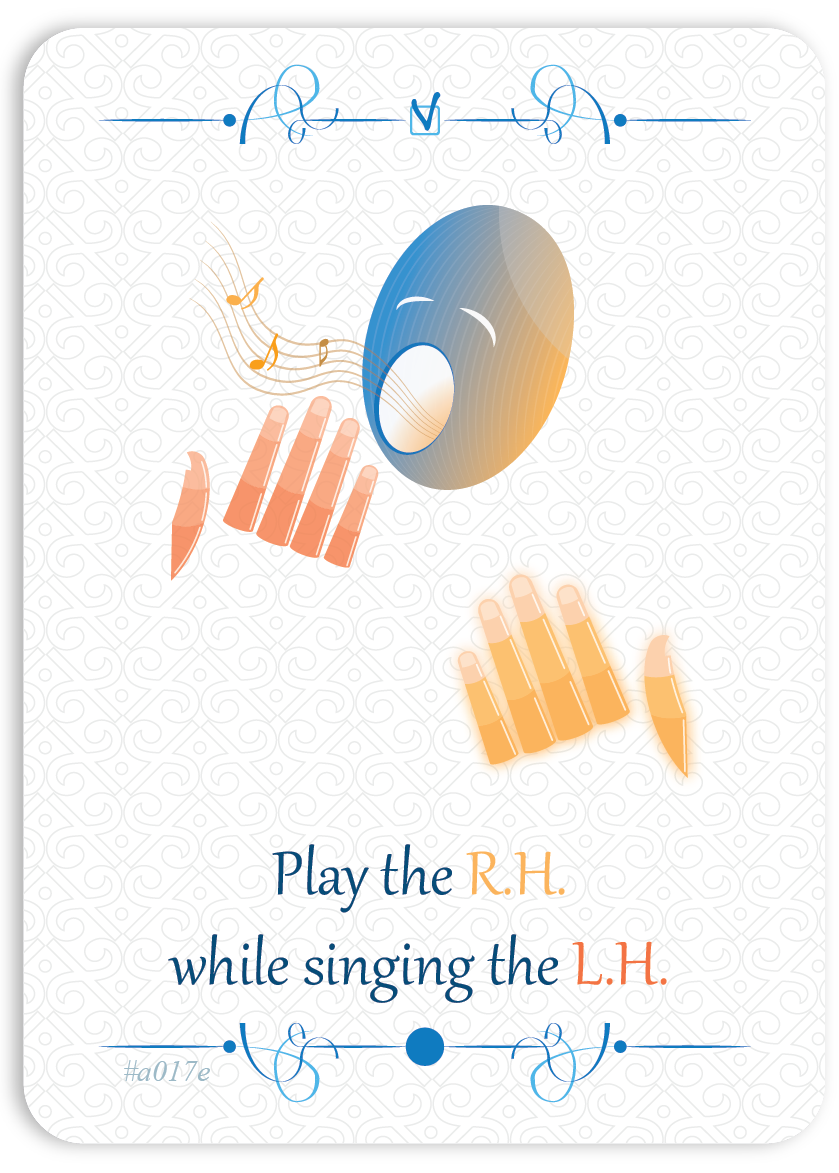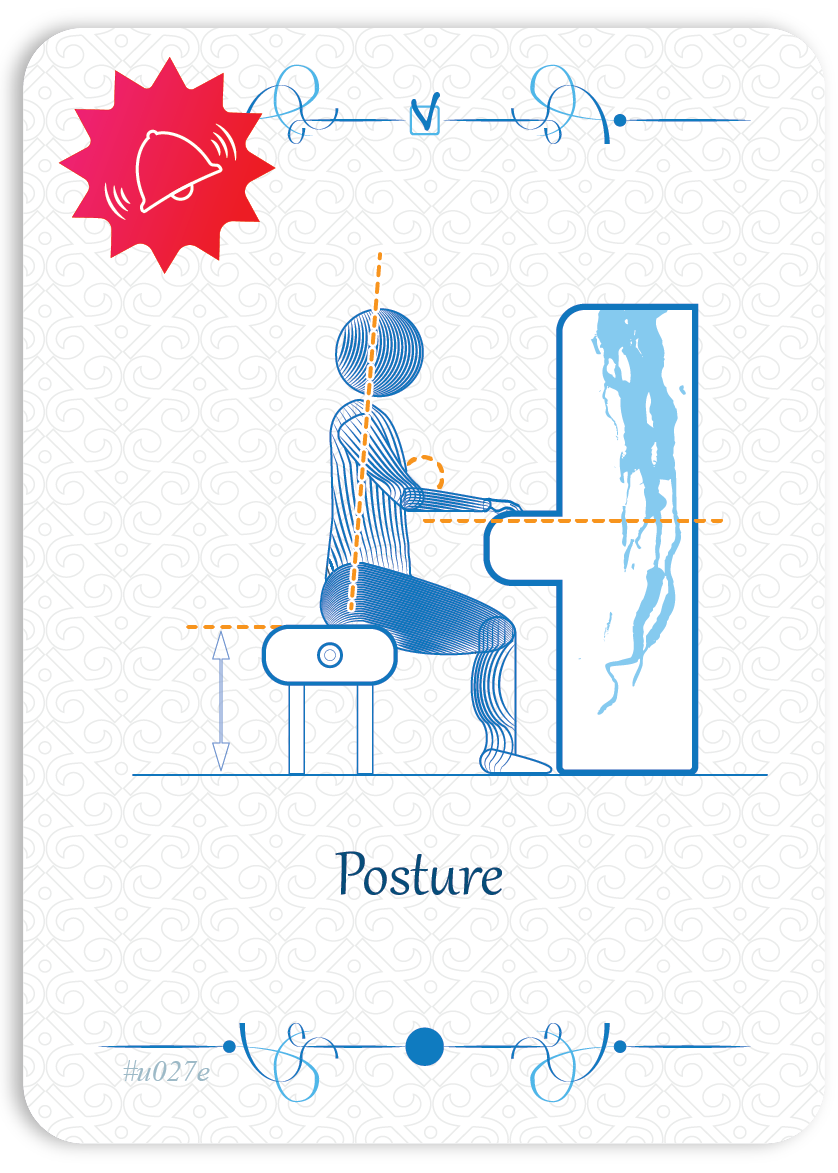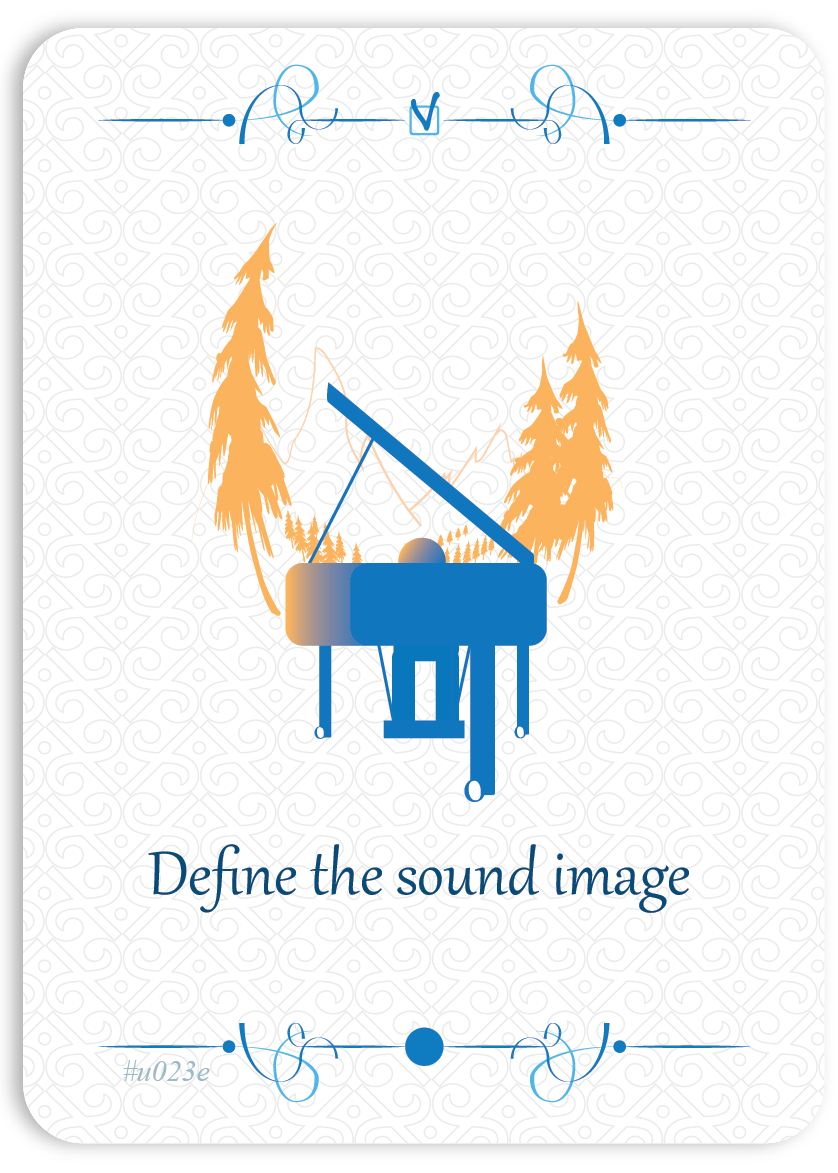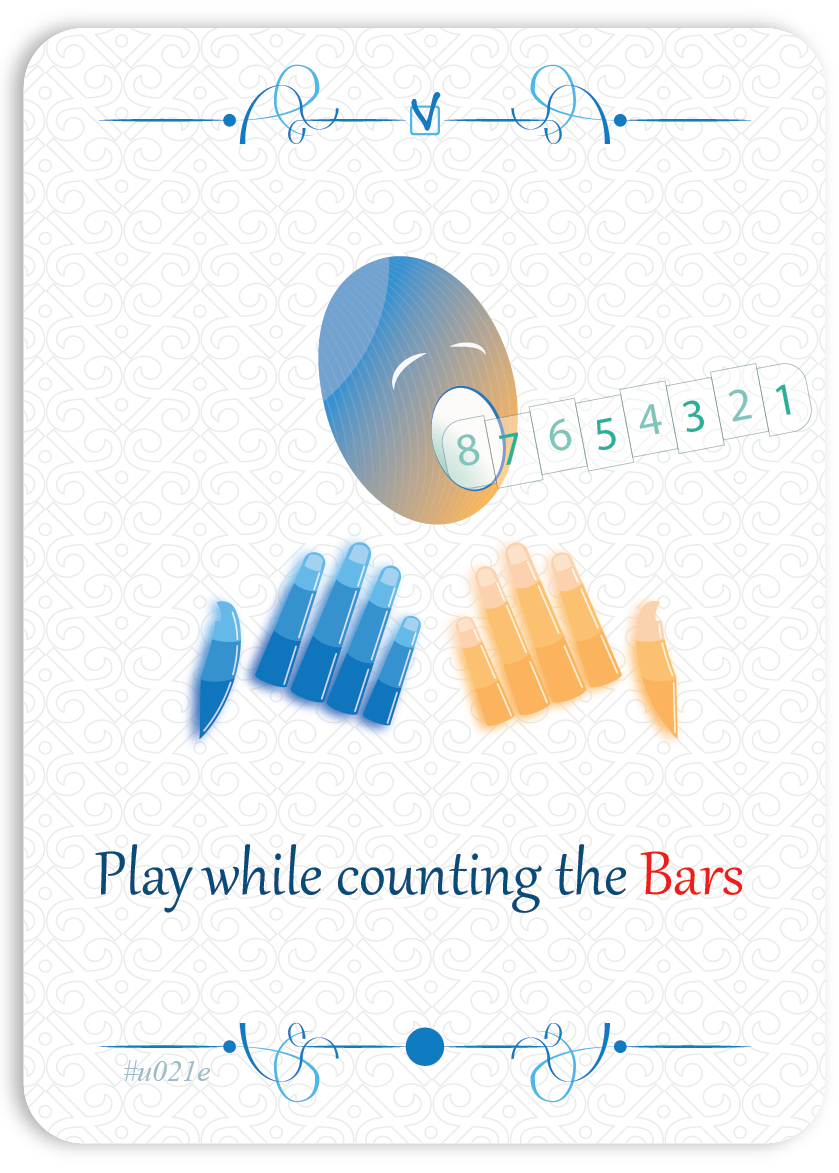Super Deck
In this deck1, you will find all the learning methods presented on the site. The tips below are especially useful for deepening your practice of a piece you have already started, or for assessing the strength of your learning skills, particularly a few weeks before an event such as a concert.
- Select a short passage of your piece (2 to 8 measures) and apply the exercise suggested on the card, as described below.
- ⚠ If the card doesn’t suit you, move on and continue practicing with other exercises in the deck.
______________
1 This deck contains 34 cards and is carefully shuffled each time you consult it.
The stars below each card indicate the difficulty level of the exercise.
→ Swipe from one card to the next by sliding your finger across the card you see.
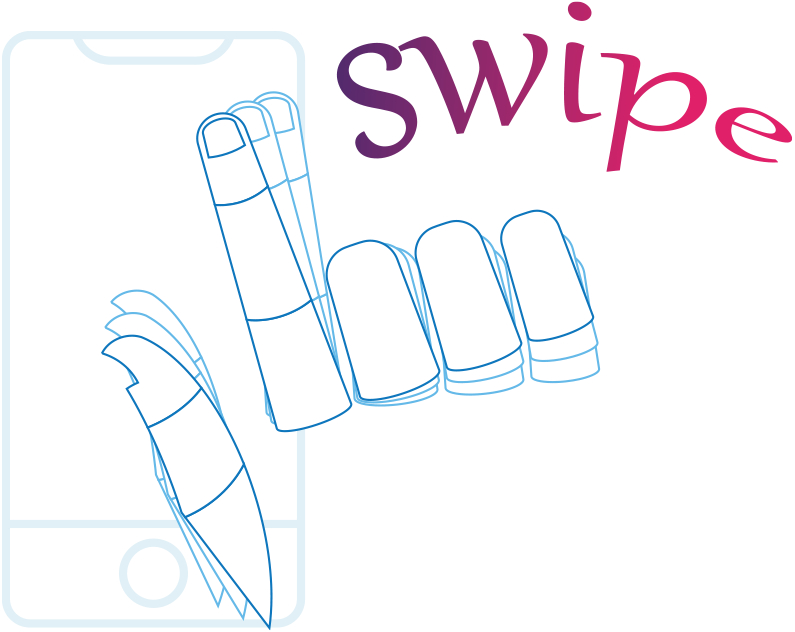
-
Play in your head
★★★→ Am I able to run through my piece in my mind while imagining my movements?
Now, project yourself more specifically into the execution of the piece. Close your eyes and imagine that you are playing.
Visualize how your torso and arms will move (as if you were playing for real)
Imagine how you will position your fingers on the keys
Picture the distances between the different intervals
Envision all the movements you will make to perform the piece. Run through this “choreography” in your mind while keeping a steady pulse. Start slowly and in small sections. Then gradually increase the tempo, connecting the movements smoothly.
-
Note the keys
★★★→ Am I aware of the tonal centers?
Identifying and becoming conscious of the tonal structure is essential for creating a sort of mental map that will guide your playing.
Mark the different keys of the piece or fragment you are working on in your score.
Example : C major, A minor, F major, etc.Play and say the keys out loud.
Indicate the various harmonies that occur between tonal centers, using chord symbols if possible.
-
Play while singing the R.H.
★✩✩→ Am I able to play while singing the right-hand part?
Sing the right-hand part using the note names while playing. Make sure to sing it with the appropriate 1 dynamics, 2 articulations, and 3 progressions.
______________
1 Dynamics : piano, forte, mezzo-forte, pianissimo. Also called dynamics, these indicate different ways of expressing the music—for example, a soft voice (piano), a strong voice (forte), or a very soft voice (pianissimo), etc. Download the dynamics sheet
2 Articulations : legato, staccato, tenuto. These are the different ways of connecting or separating notes: smooth and connected (legato), detached (staccato), or holding a note for its full value (tenuto).
3 Progressions : crescendo (gradually louder), diminuendo (gradually softer), accelerando (gradually faster), ritenuto (slowing down). These indicate gradual changes in dynamics or tempo, little by little.
-
Practice without pedals
★★★→ Have I practiced playing without the pedals?
To better memorize the lengths of the notes and the distances between the keys, practice without using the sustain pedal or the soft pedal (also called the “Una Corda” pedal).
-
Make contact with the keys
★★★→ Am I able to pay attention to the contact with the keys?
Now, focus all your attention on how your fingers meet the keys.
- What is the temperature of the keys? What is their texture?
- Are there certain keys that feel less clear or responsive than others?
-
Practice without sound
★★★→ Does playing with my ears covered unsettle me?
To introduce an additional challenge, try covering your ears with noise-canceling headphones, a construction helmet, or even earplugs. This uncommon practice will help you focus more intensely on your inner singing, your interaction with the keyboard, and your movements.
If you have a digital piano, practice your piece—or just a section of it—with the sound turned off.
-
Free the wrist, elbow, and collarbone
★★★→ Are my joints flexible?
Check that your joints are fully mobile and that your muscle tone is not excessive.
To relax the muscles between your head and shoulders (the trapezius muscles), gently lower your shoulders and move your head to the left, then to the right, twice.
Next, make small circular movements to check the mobility of your shoulder blades and collarbones.
Finally, ensure that your elbows and wrists can move freely without resistance.Continue to pay attention to this overall mobility while playing your piece.
-
Focus on Dynamics
★✩✩→ Have I carefully detailed the dynamics 1?
Now review the dynamics in your piece:
by assigning a distinct emotional character to each dynamic
by establishing the hierarchy 2 from the softest to the loudest dynamic
Download the dynamics sheet
______________
1 Dynamics : piano, forte, mezzo-forte, pianissimo. Also called "dynamic markings," these indicate the different ways of expressing musical content—for example, softly (piano), powerfully (forte), or timidly (pianissimo), etc.
2 Hierarchy : the organization of a set in a sequence where each element is stronger than the next (Le Robert, 2023)
-
Learn th L.H. by heart
★✩✩→ Have I learned the left-hand part by heart?
The left hand often carries the "harmonic rhythm" (the rate at which the harmonies change).
It is important to learn it by heart to strengthen your memory.
Approach it as if it were a piece on its own. A piece that might feel a little unusual—enjoy this strangeness as part of the charm of the music. -
Practice with the metronome
★★✩→ Am I able to play with a metronome?
Rhythmic strength gives a unique dimension to our musical expression. To work on musical timing, using a metronome can be helpful, as it indicates the beat and highlights any deviations from it. It is crucial to study a passage with extreme metric precision before eventually allowing yourself to deviate from it in order to achieve a more expressive, living sense of time.
It is important to remember that the metronome is only a tool—a means to establish and check rhythm. It should never be considered a guarantee of expressive playing, nor an end in itself.
-
Tempo Increases: Set the metronome to a comfortable tempo. Play the passage several times. Then, increase the tempo by 3–5 BPM (beats per minute) and play the same passage again. Continue gradually increasing the metronome speed until you reach the desired tempo, then gradually return to the slow tempo you started with.
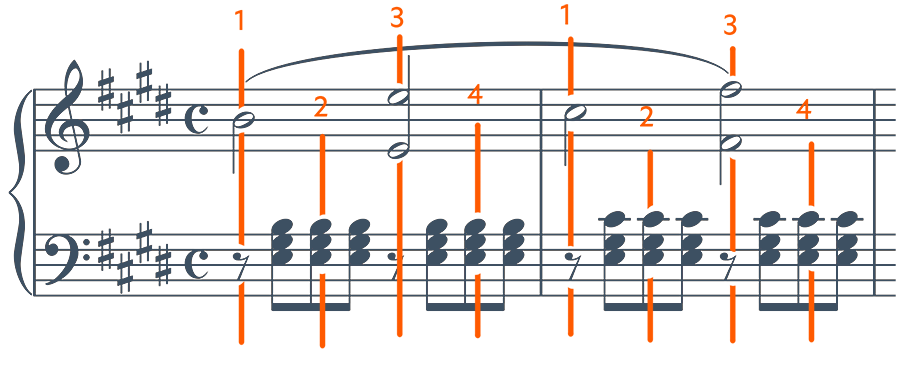
BEETHOVEN - Sonata Op.14 No.1; 1st movement (measures 1-2) -
Off-beat metronome: Now the metronome ticks on the weak beats. This exercise may seem challenging at first, but once mastered, it will greatly strengthen your sense of pulse.
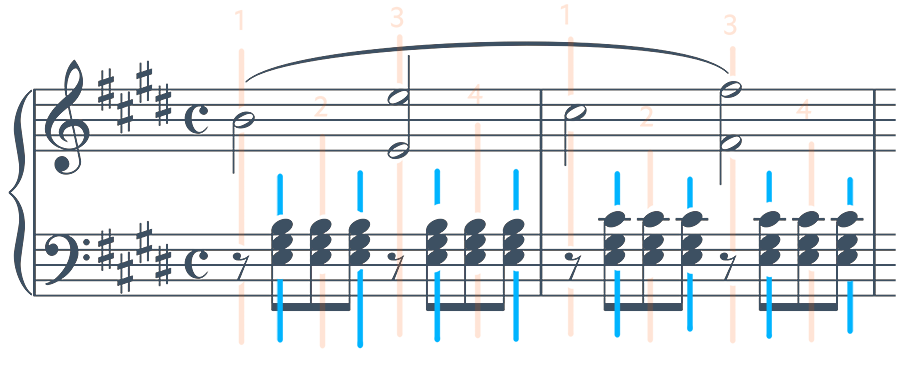
-
Measure metronome: The metronome now marks the full measure (very slow beats).
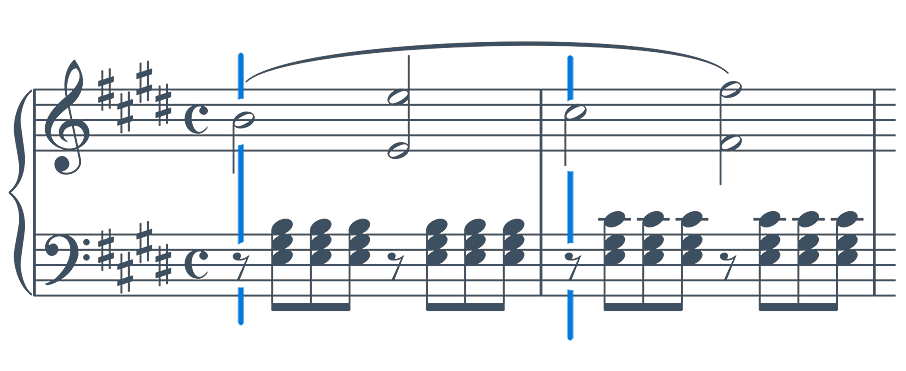
-
-
Play with your eyes closed
★★★→ Am I able to play with my eyes closed?
This exercise is useful for strengthening several aspects of your playing:
- Your memory
- Your inner singing
- Your sense of the keyboard
Close your eyes and play slowly several times until you feel comfortable at a slow tempo.
Repeat the exercise at a slightly faster tempo.
This exercise can be challenging, so if you encounter difficulties, it is better not to rush toward the final tempo.
Introducing a small disruptive element during your practice can be beneficial, while keeping it realistic: on stage, the constraint of playing with eyes closed will not be present. -
Play on the lid
★★✩→ Is it easy for me to play on the piano lid?
This exercise, when done with focused attention, offers many benefits. It helps you memorize fingerings, become aware of the pads of your fingers, and learn the distances between the keys. It also trains you to imagine the sounds and project yourself into the "sound image" of your piece, creating a kind of "narrative."
For this exercise, play your piece on the piano lid or on a table while singing, and then repeat it without singing.
It’s true that this exercise can be challenging and unsettling. At first, you might forget your fingerings or struggle to "play." Don’t worry—this requires an unusual form of dissociation. If this happens, calmly return to your sheet music and focus on a small section of the passage you are working on. Play it slowly on the piano, then try it again on the lid.
The sections that feel most destabilizing on the lid are often precisely the ones that need the most refinement.
-
Record / Listen
★✩✩→ Did I practice while recording myself?
When we play, it’s not always possible to fully grasp the overall sound picture we produce, since we have multiple elements to manage at the same time. This is why recording yourself can serve as an objective reference.
Record yourself and answer the following questions:
Is the “artistic intention” you want to convey to the audience actually perceivable?
What discrepancies, if any, do you notice between what you intended and what you hear on the recording?
Make a second recording, adjusting the aspects that caught your attention the first time.
-
Translate the markings
★✩✩→ Are all the markings on the score clear to me?
If there are any words you don’t understand, look up their meanings and write the translations directly on your score.
Think about how these markings can influence your playing and incorporate these ideas into your interpretation.
Download the most common musical terms (in Italian)
-
Detailing the sound layers
★★✩→ Have I organized the sound layers effectively?
In most pieces, you can distinguish three layers (or "planes") of sound: the melody, the bass, and the accompaniment. It is important to establish a hierarchy among them. Here are their characteristics:
1. The melody is a musical line with a strong identity, easily recognizable, and often simple to sing and memorize. It usually occupies the higher registers and is generally the top line (except in rare cases where it appears in the middle or lower registers). The melody should be placed in the "foreground" of the musical texture, meaning it should be significantly louder than the other layers.
However, it is essential to pay attention to the hierarchy of notes within this line. Even though it dominates, not all notes should be played with equal emphasis.2. The bass provides the harmonic foundation. It occupies the "second plane" of the sound, being less prominent than the melody but more important than the accompaniment. It is the lowest line.
3. The accompaniment is the least prominent layer, sitting between the extremes.
It functions as a sort of harmonic reverberation, offering support and depth to both the melody and the bass.
It is worth noting that this layer can, of course, be subdivided into several sub-layers, which in our imagination could be played by different orchestral instruments.Example 1:
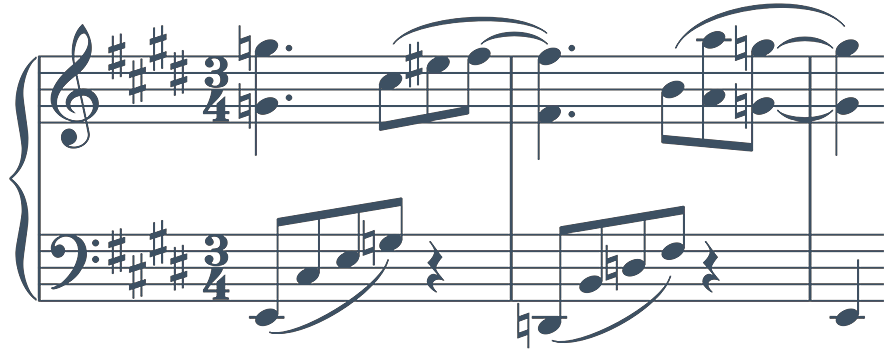
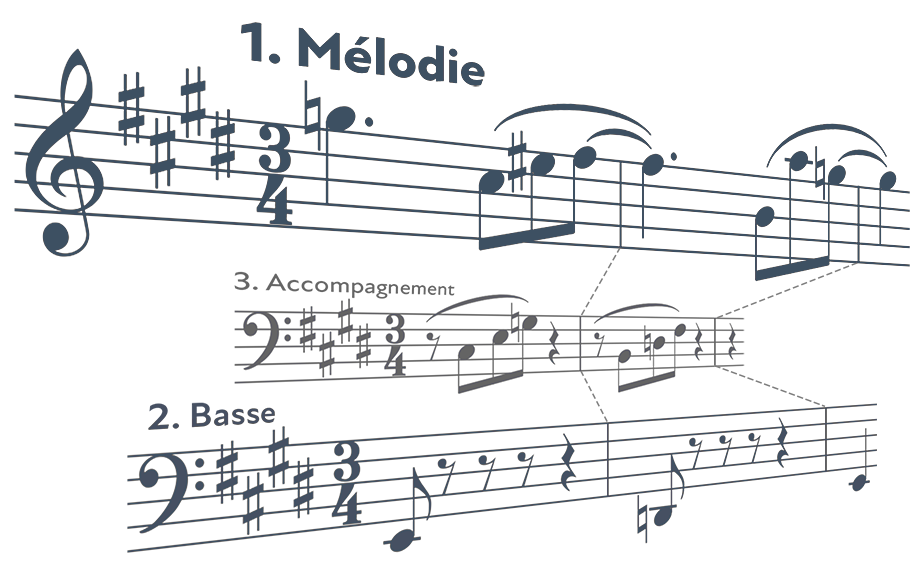
BRAHMS - Intermezzo op.119 no.2
(measures 56–57)______________
1 Here, we can clearly distinguish the three layers. You may have noticed that some notes disappear when making this distinction. These notes would fall into a fourth layer that we chose not to include so as not to complicate the concept of sound layers. -
Review the intervals
★★✩→ Am I aware of the intervals in the melodic line?
To achieve greater clarity and expressiveness in a melodic line or motif, it is important to become conscious of the intervals between non-adjacent notes.
- Mark the intervals of the motivic lines on your score.
Example: M3 (major third), P4 (perfect fourth), m6 (minor sixth), etc. - Say the interval names aloud while playing at a moderate tempo.
- Try to identify and internalize an interval by simply listening to it, without needing to name it aloud.
- Mark the intervals of the motivic lines on your score.
-
Both hands while counting
★✩✩→ Do I have a clear understanding of the beats?
Play all the notes hands together while counting the beats out loud.
You can also "walk" the pulse at the same time.
Walking the pulse means lifting your feet alternately (one, then the other) so that the foot leaves the floor completely, then returns to the floor in sync with the note you play and sing. -
Be fully present
★★★→ Am I able to listen to myself with an "external ear"?
You have probably already noticed that when we play in the presence of someone else, our performance can change significantly. It may become more expressive, or perhaps more tense, because our awareness of being observed intensifies.
So why not be fully present while practicing, since this state of attention will naturally occur when performing on stage? By getting used to entering this heightened state from the start of practice, the difference between "at-home" playing and stage playing will be minimal, helping us feel more comfortable in public.
As Robert Schumann 1 advised: "It does not matter who is listening when you play. Always play as if you were in the presence of a master."
______________
1 SCHUMANN, R. (1848). Advice to Young Musicians. -
Play the L.H. while singing the R.H.
★★✩→ Is it easy for me to play the left hand while singing the right hand?
Play the left hand alone while singing the right-hand part. If the right hand carries the melody of your piece, it will feel as if you’re accompanying yourself, which can be very satisfying!
This exercise helps develop coordination and the ability to listen to two voices simultaneously. At first, it may feel a bit challenging until you get used to it. However, persevere, because the rewards in fluency and musicality are very gratifying!
-
Slow tempo - smooth connection
★★✩→ Am I able to play very slowly?
It is important to repeatedly clarify all aspects of your piece (rhythm, notes, dynamics, gestures, etc.) at a very slow tempo, while ensuring that this approach does not create stress. Working slowly will allow you to assimilate all the gestures calmly, helping to prevent what could be considered mistakes.
Place both feet near the pedals.
Choose a very slow tempo.
Try to connect the notes smoothly with your fingers.
Pay attention to your pulse. If you encounter difficulties, your pulse may fluctuate at first. However, in any situation, it is essential to be aware of perceiving it.
-
Micro-groupings
★★✩→ Have I broken the passage I’m working on into short motifs?
To chunk – to break into pieces (Eng.)
Just like in spoken language, musical phrasing is organized into sentences, which themselves are made up of words consisting of several syllables. We’ll call these words “chunks.” Within each measure, divide the musical line into small groups of 2, 3, or 4 notes (no more). Play each “chunk,” pausing briefly on the last note of the group.
Then, play through continuously while keeping the separation of groups in your mind—without making it audible, of course. You’ll likely notice that the entire section becomes clearer for you and, by extension, for your listener.
This exercise is especially helpful for clarifying fast passages.
______________
The example shown on the card: MOZART - Piano Sonata No.17 K.545; 1st movement (measure 9) -
(Re)define the direction of the phrase
★★✩Try to identify the notable musical event in each musical phrase. This could be a dynamic change—such as a forte, a pianissimo, or an accent—or a harmonic color that stands out from the rest. Often, this event is preceded by a “progression”—crescendo, diminuendo, accelerando, ritenuto, etc. Like an important star, this event acts as a kind of “center of gravity” that draws the musical material toward it. It is also commonly referred to as the climax or culminating point.
-
Both hands while walking the Beat
★✩✩→ Am I able to play with both hands together while “walking” the beat at the same time?
Play both hands together while “walking” the beat.
Walking the beat means lifting your feet alternately (one, then the other) so that each foot leaves the floor completely and then returns in sync with the note you play and sing.
If you encounter difficulties, you can mark the beats on your sheet music. This will help you locate them more easily.
Draw “beat lines” across both staves (this is useful because it highlights coordination between the hands). The space between two lines should correspond to exactly one “beat.” The duration between two beat lines is always consistent.
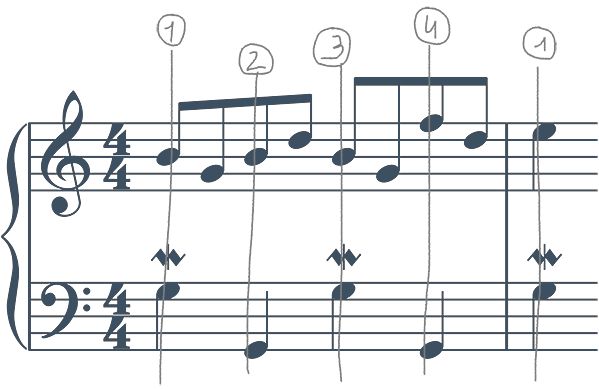
-
Listen for the note names
★★✩→ Can I hear the note names while playing?
Deepen the accuracy of your listening by following these three steps:
Start by saying aloud the names of the notes in the melody, then in the bass line, while playing both hands together.
First do this while playing, then see if you can do it without playing, focusing solely on singing the note names.
Finally, without saying the note names aloud and while playing only, try to hear how the note names resonate internally.
-
Both hands while walking by Bars
★✩✩→ Am I able to play with both hands together while “walking” the beat on the downbeat of each measure?
Play both hands together while “walking” only on the first beat of each measure.
Walking the beat means lifting your feet alternately (one, then the other) so that each foot leaves the floor completely and then returns in sync with the note you play and sing.
-
Play while singing the L.H.
★✩✩→ Am I able to play while singing the left-hand part?
The left hand itself forms a large melody, very different from the right hand. It is essential to be able to sing it accurately and to memorize it so that it can properly support the right hand.
Sing the left-hand part using the note names while playing. Make sure to sing it with the appropriate 1 dynamics, 2 articulations, and 3 progressions.
______________
1 Dynamics : piano, forte, mezzo-forte, pianissimo. Also called dynamics, these indicate different ways of expressing the music—for example, a soft sound (piano), a strong sound (forte), or a very soft sound (pianissimo), etc. Download the dynamics sheet
2 Articulations : legato, staccato, tenuto. These are the different ways of connecting or separating notes: smooth and connected (legato), detached (staccato), or holding a note for its full value (tenuto).
3 Progressions : crescendo (gradually louder), diminuendo (gradually softer), accelerando (gradually faster), ritenuto (slowing down). These indicate gradual changes in dynamics or tempo, little by little.
-
Slow motion
★★✩→ Am I able to play very slowly?
Practice playing your piece—or the passage you are working on—at an extremely slow tempo, while maintaining precise pulse. This exercise will help strengthen your memory.
-
Pay attention to how the sound fills the space
★★★→ Am I able to hear the sound in space?
In certain spaces (rooms or halls), you can notice the phenomenon of reverberation – a kind of very quick echo.
Try to focus your attention on this phenomenon while playing your piece or the passage you are currently working on.
If your instrument is in a "dry" acoustic environment where this effect is not audible, try to imagine the space where you will perform next. This could be a practice room or a concert hall. This exercise will train you to adapt to different acoustics.
-
Play l.h. while walking the Beat
★✩✩→ Am I able to play the left-hand part while singing it and walking the beat at the same time?
Play the left-hand part, sing it, and mark the beat by “walking.” Walking the beat means lifting your feet alternately (one, then the other) so that each foot leaves the floor completely and then returns in sync with the note you play and sing.
If you find this challenging, you can mark the beats on your score to help identify them.
Draw “beat lines” across both staves. This method is useful because it highlights coordination between the hands. The space between two lines should always correspond to one beat. The time that passes between two beat lines is always the same.

-
Conduct by humming
★✩✩Hum = Sing softly
→ Am I able to sing while marking the pulse without playing?
Sing the melody of the section softly, as if it were a lullaby, while keeping the pulse or conducting.
Then try it without looking at the score.
This “song” is a kind of essence of your piece that you will embody through the instrument. Remember that 1dynamics
, 2articulations, and 3progressions are all part of the music.
Download the worksheets:
1 Dynamics: piano, forte, mezzo-forte, pianissimo. Also called dynamic levels, these are the different ways to convey musical content—for example, softly (piano), powerfully (forte), or gently (pianissimo), etc.
Download the dynamics worksheet2 Articulations: legato, staccato, tenuto. These are the different ways of connecting notes: smoothly (legato), detached (staccato), or holding each note carefully for its full value (tenuto).
3 Progressions: crescendo (getting louder), diminuendo (getting softer), accelerando (getting faster), ritenuto (slowing down). These are the gradual ways (little by little) to change dynamics or tempo.
-
Play r.h. while walking the Beat
★✩✩→ Am I able to play the right-hand part while singing it and walking the beat at the same time?
Play the right-hand part, sing it, and mark the beat by “walking.” Walking the beat means lifting your feet alternately (one, then the other) so that each foot leaves the floor completely and then returns in sync with the note you play and sing.
If you find this challenging, you can mark the beats on your score to help identify them.
Draw “beat lines” across both staves. This method is useful because it highlights coordination between the hands. The space between two lines should always correspond to one beat. The time that passes between two beat lines is always the same.

-
Play the R.H. while singing the L.H.
★★✩→ Is it easy for me to play the right hand while singing the left hand?
Play the right hand alone while singing the left-hand part. If there are double notes, choose a “line” to follow—either the upper voice or the lower voice of the left hand—and then switch. Turn the left-hand part (the bass) into a true melody that interacts with and accompanies the right-hand melody.
-
Posture
★✩✩→ Do I pay attention to my posture? ?
When we play, it is not always possible to fully perceive the entire sound image we are creating. This is why recording can serve as an objective reference.
Record yourself and consider the following questions:
- Is the “artistic intention” you wish to convey to the audience potentially perceptible?
- What discrepancies do you notice between what you planned and what you hear in the recording?
Make a second recording, correcting the issues you noticed.
-
Define the sound image
★★★→ Have I developed a narrative?
The “sound image” corresponds to what the music represents to you.
Ask yourself what “story” lies at the heart of the fragment you are working on:Does it evoke a particular emotion for you?
Does it remind you of real-life events?
At this stage of learning, the goal is to articulate the “deep” motivation that makes you want to play this fragment. This motivation is sometimes called the “artistic task”.
Consider what you want to communicate to your audience through this section. Even if your “narrative” doesn’t directly reach them, the clarity of your intention will inevitably engage their imagination.
-
Play while counting the Bars
★★✩→ Do I know how many measures are in each phrase?
To develop a sense of unity within the fragment, write the measure number above each bar, then play both hands together while counting the measure numbers out loud.
Suppose your fragment has 4 measures. In this case, write the measure numbers in reverse order, like this:
“4” for measure 1;
“3” for measure 2;
“2” for measure 3;
“1” for measure 4.This reverse numbering is very useful because it shows how many measures remain before the next fragment.
- Play in your head
- Note the keys
- Play while singing the R.H.
- Practice without pedals
- Make contact with the keys
- Practice without sound
- Free the wrist, elbow, and collarbone
- Focus on Dynamics
- Learn th L.H. by heart
- Practice with the metronome
- Play with your eyes closed
- Play on the lid
- Record / Listen
- Translate the markings
- Detailing the sound layers
- Review the intervals
- Both hands while counting
- Be fully present
- Play the L.H. while singing the R.H.
- Slow tempo - smooth connection
- Micro-groupings
- (Re)define the direction of the phrase
- Both hands while walking the Beat
- Listen for the note names
- Both hands while walking by Bars
- Play while singing the L.H.
- Slow motion
- Pay attention to how the sound fills the space
- Play l.h. while walking the Beat
- Conduct by humming
- Play r.h. while walking the Beat
- Play the R.H. while singing the L.H.
- Posture
- Define the sound image
- Play while counting the Bars
Discover the tips :
Simple ★✩✩
Intermediate ★★✩
Advanced ★★★
Super Deck
